
Sunday | October 23, 2022
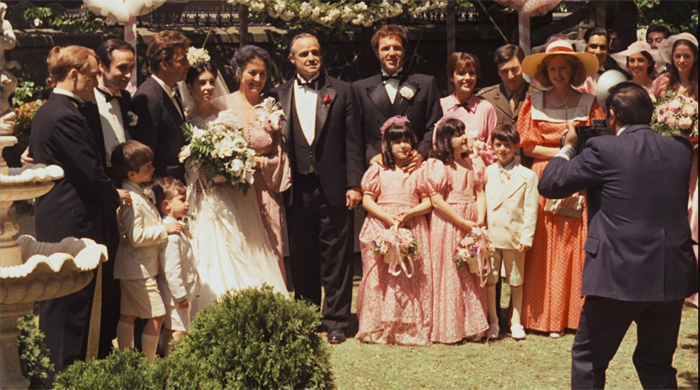
The Godfather (1972).
DB here:
This year I caught up with three powerful books. The first was Noël Carroll’s Classics in Western Philosophy of Art: Themes and Arguments. I’ve praised Noël’s work previously on The Blog, and this volume didn’t disappoint.
It’s a survey of major philosophers’ efforts to define art and explain its appeal. Starting with Plato and ending with Clive Bell, it’s an entertaining, in-depth analysis of their theories and disputes. I learned a lot from every chapter, especially about figures I hadn’t known, like Francis Hutcheson. Of particular interest was Noël’s account of a major trend in modern thinking about art, which he calls Autonomism.
This view holds that an art work is defined by features that are unique to art, and that our “aesthetic experience” of an art work is radically unlike other experiences. The Autonomist view is often expressed as a version of “formalism,” the effort to anchor artistic purity and aesthetic experience in some conception of artistic form. As in his earlier Art in Three Dimensions (2012), Noël subjects this trend of thought to a devastating critique.
Carroll’s book speaks to two other books I had to have. One is a new translation of Victor Shklovsky’s On the Theory of Prose (1925), the landmark volume of Russian Formalist literary theory. The other is Permanent Evolution: Selected Essays on Literature, Theory and Film, by another major Formalist, Yuri Tynianov. The Formalist school emerged in the 1910s but by the end of the 1920s it had petered out, chiefly because of withering attacks. As the name implies, the Formalist writers were vulnerable to charges of simply chasing after fancy filigree and ignoring the real stuff of art, “content”–particularly its social and political dimensions. (The label “Formalist” was initially applied by opponents; the Formalists called themselves “specifiers.”)
Their work has been periodically rediscovered without ever gaining long-term recognition. René Wellek and Austin Warren’s Theory of Literature (1949) introduced their ideas to the English-speaking world, but the literati played down this aspect of the book. A timid 1956 survey (Victor Erlich, Russian Formalism: History and Doctrine) left many readers thinking that the school was a variant of Anglo-American New Criticism and just as blind to cultural implications. Now Shushan Avagyan’s careful translation of Shklovsky and the superb, refreshingly scathing introduction to the Tynianov collection by Daria Khitrova might change this long-standing bias, but I fear that most readers will consider these writers and their peers relics from a bygone era.
Which would be a pity, in my view. The Formalists changed my idea of film research. Several contributed scenarios to movies, and they composed essays in film theory, but it’s been their literary theories that taught me more about cinema. Now, reading Carroll and rereading Shklovsky and Tynianov have sharpened my sense of what’s valuable in their work.
In their early thinking, their theory of art in general is somewhat vulnerable to Carroll’s Autonomist critique. However, they were evolving away from that sort of purism when they were shut down by political dogma. From another angle, their empirical research into literary forms offers us many tools for understanding films. It’s the difference between a philosophy of art and a conceptually driven criticism.
If you want to be fancy: As an ontology and psychology of art in general, Formalism is problematic. But as a methodological perspective, it’s very rewarding. Or so I’ll suggest.
Getting automatized
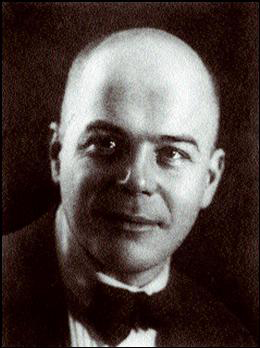 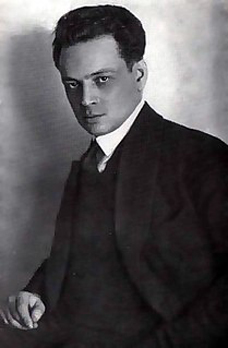
Victor Shklovsky and Yuri Tynianov.
In most of the debates about “form,” that usage refers to two aspects of an art work. There is the overall relation among parts of the whole. In music and painting, it’s called “composition,” but the term obviously wouldn’t work for film. So “form” can refer to structural relations at various levels: acts in a play, chapters in a book, phases of a plot, sections of a scene. Then there’s style, the patterned and functional use of the materials of the medium: the arrangement of melodies and harmonies, the use of paint, the organization of film techniques. I’ll mostly refer to both as “form” in what follows, but sometimes I’ll need to refer to them separately.
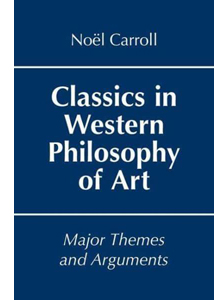 Carroll argues that as Western science forged ever more powerful ways of explaining the world, some thinkers took art to be “a realm unto itself, apart from the claims of utility, morality, politics, religion and so forth, a realm of art for its own sake.” Hutcheson and Kant developed ideas of beauty and our experience of it as radically distinct from other activities, and Schopenhauer extended these ideas to the realm of art works. The emergence of program music and post-Impressionist painting gave support to the notion that art works are self-sufficient. Now that art was no longer seen as a craft, as the Greeks had believed, it became a source of pleasure in its own right–an attractive idea to bourgeois patrons. Carroll argues that as Western science forged ever more powerful ways of explaining the world, some thinkers took art to be “a realm unto itself, apart from the claims of utility, morality, politics, religion and so forth, a realm of art for its own sake.” Hutcheson and Kant developed ideas of beauty and our experience of it as radically distinct from other activities, and Schopenhauer extended these ideas to the realm of art works. The emergence of program music and post-Impressionist painting gave support to the notion that art works are self-sufficient. Now that art was no longer seen as a craft, as the Greeks had believed, it became a source of pleasure in its own right–an attractive idea to bourgeois patrons.
This attempt to define the necessary and sufficient conditions of art culminated in Clive Bell’s Art (1914), which argued that the distinctive feature of the art work was “significant form.” Its identity as art depended, in Carroll’s words, “on its internal logic or internal structure.” Bell’s primary concern was painting, in which significant form is “arresting configurations of shape and hue that give a painting its unity.” Representing the visual world is a secondary, non-artistic goal; recognizable things are in a picture only to support its underlying form. As for the viewer, she undergoes an “aesthetic experience” insofar as she has a disinterested appreciation of significant form. Subject matter and theme are at best subordinate, at worst irrelevant, to experiencing form. The art work, and art in general, are in principle autonomous from what Carroll calls “the world of suffering.”
Autonomism has been a powerful influence in modern art, fueling many critical movements, notably musicology, New Criticism in literature, and studies of abstract painting. Carroll allows that it has had salutary effects in encouraging people not to overlook form and style. But he objects to elevating form as the determining factor in a philosophy of art in general.
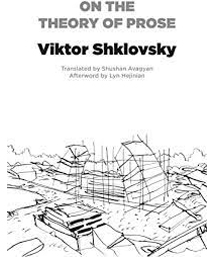 I’ve had to be too quick in reviewing Carroll’s account, but I think it’s clear that when the Russian Formalists pronounced on art in general they sometimes moved toward autonomy assumptions. Shklovsky once remarked that art didn’t care about the color of the flag flown on the fortress. “By objects of art, in the narrow sense, we mean things created through special devices designed to make them as obviously artistic as possible.” Here we have both the idea of all-powerful form and the aesthetic experience that it fosters. I’ve had to be too quick in reviewing Carroll’s account, but I think it’s clear that when the Russian Formalists pronounced on art in general they sometimes moved toward autonomy assumptions. Shklovsky once remarked that art didn’t care about the color of the flag flown on the fortress. “By objects of art, in the narrow sense, we mean things created through special devices designed to make them as obviously artistic as possible.” Here we have both the idea of all-powerful form and the aesthetic experience that it fosters.
That experience, though, isn’t operating within a special, remote realm. Shklovsky famously declared that the purpose of art was to “defamiliarize” or “estrange” our perception of the ordinary world. This process doesn’t ease our retreat into a world of “pure form.” It was, he claimed, aimed at returning us to a world we normally did not notice. Habitual actions have made our perception automatic, but art removes this and “makes the stone stony.” His chief example is “Strider,” a Tolstoy short story that takes a horse as its narrator. The horse’s untutored experience of flogging, ownership, and Christian doctrine makes routine human affairs seem alien. Here the idea of “perception” is doing a lot of work, going beyond the stoniness of the stone to local habits and concepts of everyday life.
In the key essay, “Art as Device,” I think that Shklovsky sometimes conflates estrangement as an essential condition of art with estrangement as a particular technique. Most generally, writers use devices like repetition and parallelism with a wilful irrealism that makes us aware of them as “obviously artistic.” Still, the result is that we see what the techniques render in a fresh, “estranged” way. Perhaps this view lies behind the comment made by many viewers of Tati’s Play Time that they can never see an airport or a traffic circle the same way again. This is, we might say, autonomism with benefits: form demands attention in order to renew our awareness of our world.
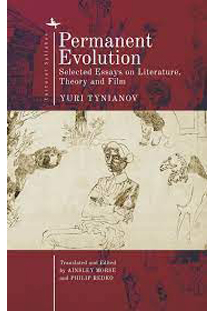 Tynianov is hard to read, but I think he’s probably best considered more of a functionalist than a formalist. True, he sometimes seems to reduce “content” to formal factors. Anticipating Roland Barthes in S/z, he calls a novel’s protagonist a “semantic unit. . . . a set of heterogeneous dynamic elements united under a single external sign,” such as a proper name. So much for characters as persons! Tynianov is hard to read, but I think he’s probably best considered more of a functionalist than a formalist. True, he sometimes seems to reduce “content” to formal factors. Anticipating Roland Barthes in S/z, he calls a novel’s protagonist a “semantic unit. . . . a set of heterogeneous dynamic elements united under a single external sign,” such as a proper name. So much for characters as persons!
Yet it seems to me that he did not consider the philosophical essence of the literary work. Every work, he maintained, was a system of elements, each with a distinct function. In some poems, such as Poe’s, rhyme takes a major role; in others, it is secondary or negligible. And the literature of any time itself forms a dynamic system, which is constantly in fluctuation. Genres promote certain elements over others, and over time, genres shift the weight they assign to given factors. At any moment, many trends are active, so that claims that an era is ruled by a certain “tradition” is an arbitrary freezing of the protean literary system.
“Literariness,” a term that the Formalists adopted, looks like the sort of essence that the Autonomist would prize. For Tynianov, though, it isn’t a fixed quality but the tendency of literary works to constantly absorb new materials, cast out old ones, and reassign functions. What drives this process is automatization and defamiliarization, but not quite in Shklovsky’s sense. What gets automatized, for Tynianov, is not everyday perception but a particular form or style. After a few years, analytical cubist painting no longer looks daring, so something new must replace it. A classic can be parodied, which exposes the limits of its techniques and opens the way for alternatives. The literary system changes when conventions of genre, construction, and style have grown stale and the literary milieu (see below) fosters novelty.
In the mid-1920s Tynianov pushed the Formalists toward a more historical conception of how literature worked. Rather than positing a philosophical position, they developed a method of criticism that exposed principles of construction open to change. Even Shklovsky moved toward historical functionalism, as he points out in his (widely misunderstood) apologia, “Monument to a Scientific Error.”
My approach consisted of taking remote examples from literatures of different eras and national contexts and of asserting their aesthetic equivalence. I studied each of these works as a closed system, outside of that system’s correlation with the literary system as a whole and with the primary, culture-forming economic plane.
Empirically, in the process of inquiry into literary phenomena, it became clear that every work exists only against the background of another work and that it can be understood only as part of the literary system. . . .
It became clear that one could not study individual devices in isolation, as all of them correlate with one another and with the literary system as a whole.
Early fruits of this new research program are visible in several Tynianov essays and other pieces by Boris Eikhenbaum, particularly his brilliant O. Henry and the Theory of the Short Story But the program never developed fully. By 1930, the Formalists had lost their institutional support and were obliged to write fiction, biography, and journalism. (Tynianov authored the now-classic Lieutenant Kizhe.) The project of Russian Formalism, as Daria Khitrova notes in her introduction to Permanent Evolution, remains incomplete.
Incomplete, but suggestive. Here are ideas that Kristin and I and others have tried to explore further, in analyzing film rather than literature.
Form vs. content? No, form vs. material
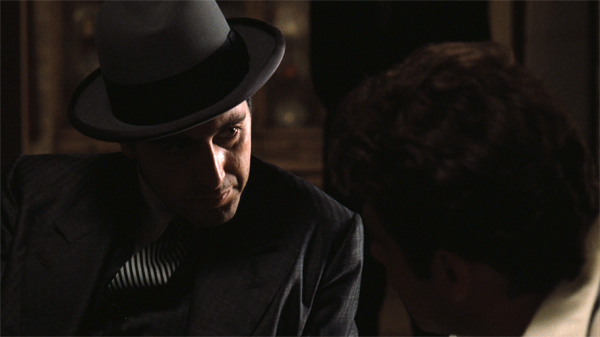
Most centrally, the Formalists challenge us to rethink the idea of content.
The metaphor of “content” makes form merely a vessel for something that’s poured in and stays intact, like coffee in a cup. Shklovsky, Tynianov, and others argued that form was transformative, pervading whatever prior materials we find in the work of art. This is obviously true of, say, music or painting, where stretches of sound and items of the visible world get fundamentally altered by the conditions of the medium. It seems harder to apply to literature, where propositional “content” can simply be stated in a novel or poem: The world is too much with us… But even bald statement is qualified by context and treatment. Shakespeare didn’t say, “Neither a borrower nor a lender be.” Polonius said that, and why should we trust him?
The filmmaker has two sorts of material, I think. There’s the stuff of the audiovisual world, either preexisting (in documentaries and some fiction films) or created for filming (as in animation and some fiction films). Then there’s ideational material, subjects and themes that can serve as material for formal work. Those obviously come from the filmmaker’s experience and from the general culture. The ideational sort of material supplies the film with an “aboutness.”
But ideational material doesn’t come raw to the task. The subject matter comes already conceptually packaged as an issue or problem–teen suicide, homelessness. Likewise, a theme is already shaped as a general topic, maybe as a proverb (There’s no place like home. Just be yourself). And like other materials, subjects and themes become part of a larger construction. The land of Oz tests Dorothy’s proverb by offering an alternative world, while in Hollywood movies learning to “be yourself” often means discovering and developing powers you didn’t know you had.
Ideational material is always filtered through the institutions of filmmaking; topics of race and gender identity are likely to be handled according to prevailing norms. (See below.) For example, narrative form often stages its thematic dynamic through conflict, such as the clash between personal preference and social duty. The plot will find ways to bring out strengths and weaknesses in each and arrive at some sort of resolution, or compromise.
The themes don’t come out unchanged. The Godfather can be said to be about the conflict of family obligation and social morality. It isn’t just about the strength of kinship ties, but the cost they exact in personal integrity. Is family loyalty okay if it leads to murder? Form doesn’t just display themes; it can interrogate them. This especially happens when “symptomatic meanings” are at work.
For examples of how subjects and themes can function in broader patterns, see these entries: “Superheroes for Sale,” “Hunting Deplorables, Gathering Themes” and “Zip, zero, Zeitgeist.”
The importance of norms
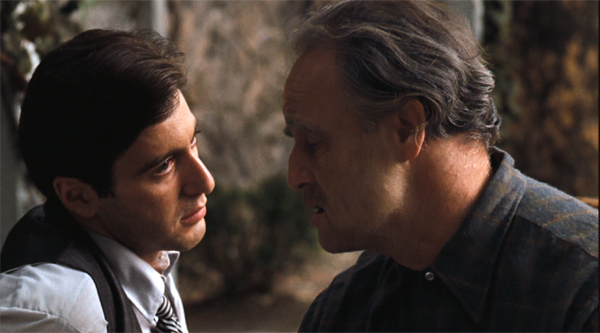
Following the Formalists, Jan Mukařovský and other Prague theorists emphasized the role of norms in any art form. (Shklovsky calls them “backgrounds.”) Through craft practice, certain devices become favored because they work on audiences, or because reigning institutions favor them. Happy endings are perennially popular; portraying Christ as a suffering martyr gets approval from Church patrons.
One implication is that norms function as pressure points for artistic choices. There is usually more than one way to do anything, but the range of choice is likely to be constrained. Norms are, I think, like a menu, presenting alternatives but still setting a limit on what can be ordered. Another implication is that norms are variable. A philosophical search for the essence of art is replaced by a methodology that tries to understand principles that inform various periods, schools, and trends. No appeal to “universal laws of art” is necessary, although it can be revealing to find that some norms cut across times and places.
A key finding of the Formalists is that genre norms are very powerful. Even when you’re not doing “genre criticism,” surveying the range of musicals or science-fiction films of a period or place, the concept of genre is fundamental to understanding the form of an individual movie. Shklovsky and Tynianov concentrated on verse genres like the ode and prose ones like the novel. Shklovsky was especially astute in pointing out how conventions of the riddle and the folktale recurred in modern literature. And he noted that genre can override ideology. A Soviet Sherlock Holmes would still need a Watson figure and an incompetent rival (perhaps a bourgeois amateur Lestrade) to build up the mystery plot.
Genre norms can dictate aspects of form. Mysteries demand fairly tight plotting, while coincidences are favored in comedy and melodramas. If they are included in other genres, they usually need extra motivation. But many films include convenient accidents, especially when it can precipitate a climax. Many denouements depend on somebody accidentally overhearing something important or discovering a fateful document, as in Get Out.
Some norms transcend genres, as the happy-ending device does. “What are you doing here?” is a line in nearly every film. Hollywood films rely on some broad norms of plot construction. Kristin has proposed, and James Cutting has confirmed, that many studio films have a four-part structure (Setup, Complicating Action, Development, and Climax), capped by an epilogue. These are based on setting up, modifying, and thwarting character goals. Similarly, many films in all genres rest on deadlines and two story lines (romance/ work or dual romances). Interestingly, norms aren’t always acknowledged by filmmakers when they discuss their work; they’re taken-for-granted aspects of craft.
Because norms offer a range of options, we find variety. Take protagonists. In modern cinema, there can be single protagonists, dual protagonists (such as a romantic couple), or multiple protagonists (as in Love Actually). Occasionally we encounter parallel protagonists (as in Chungking Express). And these devices can be tweaked. Who’s the protagonist of The Godfather? By the end, Michael is clearly the initiator of the major actions, and he has undergone the greatest change; he has a “character arc.” But at the start, and intermittently thereafter, it’s Don Vito who calls the shots. Once he’s sidelined by his wounding and recuperation, Michael comes to assume the protagonist role. When Michael retreats to Sicily, the Don resumes some control, but when Michael returns, he takes over.
The gangster movie often enacts the takeover of a crime empire by a young, audacious and even reckless striver. But in The Godfather it’s not a parvenu displacing a rival but a son replacing the father by jumping the line of birth order. The film has two characters tag-teaming the protagonist function, the purpose being to trace the fluctuations of power and contrast managerial styles. Such variants remind us that filmmakers have flexibility in assigning narrative roles.
There are stylistic norms as well. The clearest example is the continuity system of editing, which has become nearly universal in mainstream filmmaking, and is foundational for alternative practices. Other examples would be three-point lighting, nondiegetic musical scores, and walk-and-talk camera movements. Earlier in film history, there are staging norms associated with 1910s “tableau cinema.” In The Godfather, Coppola follows many stylistic norms of Hollywood cinema, but he also innovates, as when he films the garrotting of Carlo from an unusually forceful position.

Kristin and I have spent much of the last fifty years tracing how stylistic norms came about and how Tati, Ozu, Eisenstein, Dreyer, Angelopoulos, Hou, Wes Anderson, and other filmmakers have created their own variants, which can achieve different effects. Even avant-garde filmmaking has norms, as indicated by the distinct schools which have emerged, such as Expressionism, Surrealism, mythic cinema, Structural Film, and others.
A great many of our website entries illustrate the analysis of norms. Blogs under the categories Narrative Strategies, Tableau Staging, and the topics under Film Techniques provide examples. For a quick sampling, try “Intensified Continuity Revisited,” “Anatomy of the Action Picture,” “Another Shaw Production: Anamorphic Adventures in Movietown,”and the video lecture “CinemaScope: The Modern Miracle You See without Glasses.” Kristin explains four-part structure in “Times go by turns.” One historical discussion of emerging norms is “Hollywood starts here, or hereabouts.” Recently we posted an entry trying to show how across his career Godard challenged reigning norms of story and style.
Understanding narrative form and style

Landscape with the Fall of Icarus (c. 1555) by Pieter Bruegel the Elder.
Carroll points out that narrative art in any medium poses severe problems for an Autonomist formalist. When artworks tell stories, they recruit form and style to that purpose. The story itself may require knowledge “outside” the work. Carroll points out that we can’t appreciate the form of Bruegel’s painting without knowing the tale of Icarus. That gives force to the figures’ indifference to the thrashing legs in the lower right of the format. Contrary to Autonomists who saw narrative as a pretext or distraction, the Russians’ critical method eagerly sought to analyze how story contributed to form.
In the 1979 edition of Film Art, we introduced the concepts of story and plot as analytical tools, borrowing the Formalists’ distinction between fabula, the causal and chronological tale that is presented in a narrative, and syuzhet, the way that tale is composed in the final text. It was a distinction that most film researchers hadn’t pursued, but we found it very fruitful.
For one thing, it allowed us to show how the effects of a movie were carefully built up through information revealed by the plot. The plot can skip over story events, leaving them to be revealed as surprises later. The plot can rearrange story events, as when flashbacks fill in backstory and flashforwards tease us with what’s to come. Point of view is a central tactic of plot construction; constraining us to what a single character knows can increase mystery and suspense. The plot can control information through spatial maneuvers too, as when the action gets confined to a single space, such as a room (Room) or a police wagon (Clash).
Shklovsky had some very original ideas about plot. Most radically, he suggested we think of a plot as not a harmonious unity but an assemblage, sometimes a rather rickety one. He took Don Quixote as his example, arguing that Cervantes discovered his story in the act of pulling together folk tales, bits of other texts, and clichés of chivalric literature. Even the character of Quixote, he argued, was a mashup of quotations and commonplaces; he’s presented as both foolish and wise.
Shklovsky also emphasized the role of delay, the prolonging of an action beyond simple economy. The hero of an adventure novel is captured, but then escapes, only to be captured again, until it’s convenient to end the plot. Shklovsky related delay to the prevalence of repetition in oral literature: the three trials of a hero, the three roads that can be taken. Along such lines, he found Tristram Shandy, a novel built upon digressions and a constantly interrupted revelation of the hero’s injury, “the most typical novel in world literature.” In keeping with this model, Shklovsky’s essays take off in unexpected directions; his favorite angle is a tangent.
Tynianov picked up on the idea of narrative unity as a tense, even fragile thing, where different components competed for supremacy. In a narrative poem, which will rule: verse or plot? Tynianov’s insistence on dynamism within an art work, as well as among art works, gave him, like Shklovsky, an affinity with the Constructivist movement in the visual arts. The Constructivists stressed conflict among parts–like the Soviet filmmakers’ embrace of the technique of aggressive montage. A narrative, we might say, is a montage of disparate, often ill-fitting parts, and the critic shouldn’t suppress these dissonances in the name of a sacred unity. Part of the point of Bruegel’s picture is the dissonance between a placid landscape and Icarus’ violent death.
Of the many discussions of narrative on our site over the years, “Open secrets of classical storytelling: Narrative Analysis 101” offers an orienting roundup. I try to see a plot as a Shklovskian assemblage in “Pulverizing plots: Into the woods with Sondheim and Shklovsky.”
Motivation and delay
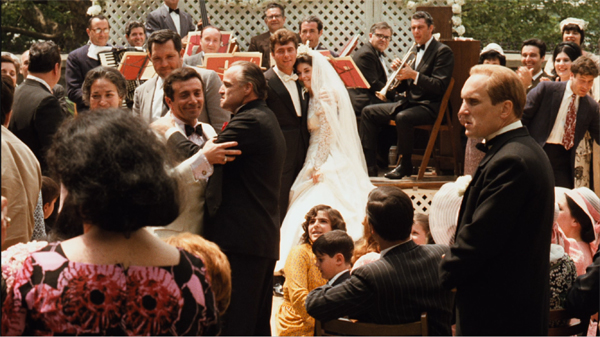
Still, we should expect that style and overall form hang together, and the Formalists weren’t reluctant to point out strategies that make a narrative coherent. Shklovsky noted that disparate plot lines could be tied together through convergence, as when unconnected characters gather at a hotel or inn. This device dominates the beginning of The Godfather, in which Connie’s wedding party brings together most of the major characters and prepares lines of action that will come. We learn of Johnny Fontane’s Hollywood problems, the role of Luca Brasi as muscle for the family, Sonny’s philandering, Michael’s romance with Kay, Tom’s role as counselor, and the gangsters who will become rivals and betrayers of Don Vito. Even the later ministrations of the mortician Bonasera are established through his initial visit to the Godfather. The party serves as the plot’s exposition of backstory and as foreshadowing of future developments.
Another coherence device is parallelism, which Shklovsky made much of. Although a story is driven by chronology and causality, the plot can compare characters and situations. The opening Godfather party draws several parallels, notably with respect to family cohesion. The Don indirectly upbraids Sonny for his infidelity while praising Johnny (“A man who doesn’t spend time with his family can never be a real man”). Crosscutting the erotic song “C’è la luna mezzo mare” with Sonny’s seduction of a wedding guest creates a more localized parallel. In a parallel highlighting contrast, Michael disavows his relatives: “That’s my family, Kay, that’s not me.” As the plot develops, Shklovsky might find the comparison of the Corleone brothers a result of parallelism, as we get to see their differing responses to the crises confronting the family business. A parallel of Don Vito and Michael is given visually, when McCluskey’s brutal punch gives Michael his father’s swollen jaw.
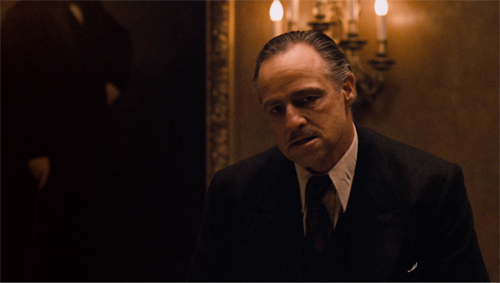
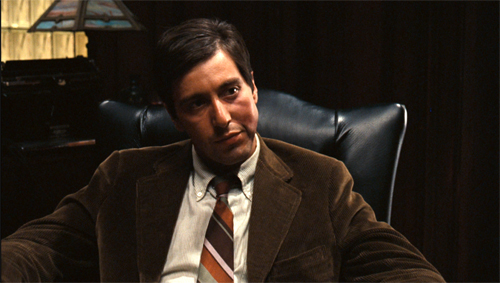
The parallel is capped by the beginning and the ending, with supplicants coming to Don Vito at the party and new followers currying favor with Michael at the close, calling him Godfather.
Yet another way narratives hang together is through motivation, the justification for the presence of some element in the story world or the plot’s presentation. Cinematographers speak of motivated light sources as sources that could plausibly be in the setting. (Such was the motivation for the overhead lighting in those hollow-eyesocket shots in The Godfather.) In general, film style is motivated by narrative demands. You cut to a close-up when you want to emphasize a detail or a character’s reaction. Admittedly, there are today some weakly motivated stylistic choices. Do we really need so many circling tracking shots of characters around a table? Such a whirling shot can be useful showing a character besieged by psychic torments, though now it’s becoming a norm.
Coincidences can be more or less well motivated. If a couple are to meet cute at a coffee shop, you can show them visiting it separately on earlier occasions before they finally encounter one another. Likewise, impossibilities like time travel can be justified simply by introducing into the story world a gadget that permits it. As this example shows, generic motivation can trump realistic motivation.
When it comes to character, motivation is usually a psychological reason for action. Mild-mannered Michael Corleone must become a ruthless killer. How to motivate the change? Well, unlike his brothers, he’s been in the war, so combat may have hardened him. His father has been betrayed and nearly killed. The police are too corrupt to intervene, so he has to protect the old man himself. Sonny is too hot-tempered to lead the family, and Fredo is too weak. And the woman Michael loves, Apollonia, is blown up by confederates of the New York gang. The lesson in Machiavellian intelligence is: Feign cooperation, but be ready to betray. That is: Keep your friends close, but….
Even delay can assist the tighter weaving of form. Here Kristin and I depart a little from Shklovsky. He thought that delay was an artistic end in itself because it prolongs perception, a good thing in itself. In our view, delay functions partly to fill out a narrative to the length demanded. Demanded by what? By the platform or format of the artistic project. A novel needs enough incidents to run 70,000 words or more. A play often demands three acts. A sitcom needs an A and a B storyline to fill out 22 minutes.
Perplexing Plots traces how the demand for novel-length detective stories obliged writers to pad things out with faked alibis, second murders, and false solutions. But “pad” isn’t the right word because delay can function positively, to create gaps that can be filled by other material–subplots, character backstory, diverting byplay, and the like. This happens in conventional Hollywood screenwriting, when story background and comic digressions prolong the Development section before the Climax. Rex Stout’s Nero Wolfe novels fill the gaps with entertaining exchanges between Nero Wolfe and Archie Goodwin, which enrich their characterizations and provide commentary on the action.
Delayed patterns of action can mutually reinforce one another. Each of the four intercut stories in Intolerance delays the plot’s resolution of the others. Similarly, viewers of long-form streaming TV series are familiar with coordinated delaying devices (“streaming bloat”) that tease us to keep bingeing. Through several episodes I kept waiting for the couple in Extraordinary Attorney Woo to kiss. Alongside this delay were major courtroom story lines that held their own interest, so that the romantic interludes served to delay the suspenseful outcome of the cases. And then once the couple kissed, they started to break up–more delay! (But motivated, of course.)
By laying out norms of plot construction, the Formalists lead us to think of how our emotions are recruited. Story/plot maneuvers can build curiosity, suspense, apprehension, and surprise. They can summon up sympathy or turn us against a character who initially seemed admirable. They can create what Meir Sternberg calls “the rise and fall of first impressions.” And they can intensify our appreciation of a character’s emotion. Suppose that Puzo and Coppola had not shown Sonny Corleone ruthlessly ambushed at the toll booth, and that we had only the Don’s grieving appraisal of the body. “Look how they massacred my boy.”
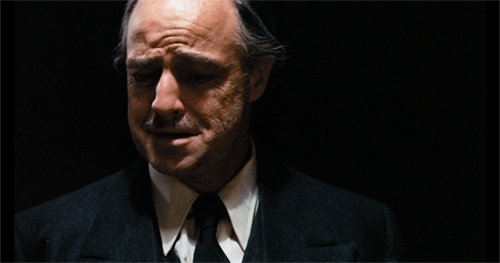
Brando’s acting pierces the heart. But having seen Sonny cut down, we realize that the word “massacre” is metaphorically apt, and we know that the father is looking at a horrendous sight. The plot includes the ambush as a story event not just for momentary shock but as a way to intensify a later spurt of sympathy.
An instance of a tightly woven plot is provided in Knives Out, as I try to show in this entry. On motivating coincidences, there’s “No coincidence, no story.” I try to convert the plot/story distinction into three analytical tools in “Understanding film narrative: The trailer” and “Three Dimensions of Film Narrative.”
Inside/outside
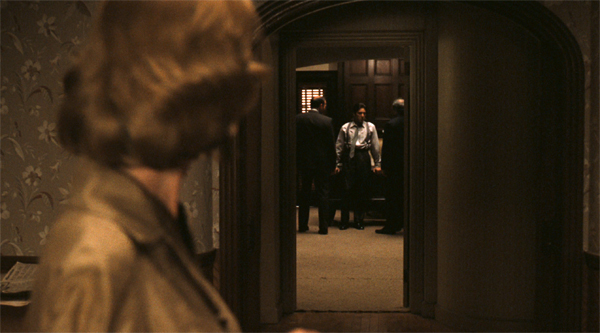
Historically, commentators have distinguished between formalism as an “intrinsic” approach to artworks and alternatives that consider social and cultural factors “extrinsic” ones. But this distinction seems misguided.
It seems that no artwork can be considered as a wholly self-sufficient entity. Noël Carroll’s argument against Autonomism rightly asks what can plausibly be said to be “inside” the artwork. Any representational art refers to persons, places, things, and ideas that exist “outside” it. To talk of characterization we rely on concepts we apply to real people. Moreover, every artwork is connected to other works. To speak of a plot’s protagonist or a climax is to acknowledge patterns of structure that it shares with other narratives. It’s significant that formalism initially gained traction in relation to post-Impressionist art and absolute music. But to identify a painting as a still life or a musical piece as a symphony is to apply a genre concept that extends beyond the individual work.
This shows that it’s not reasonable to charge a formalist approach to cinema with being reluctant to treat culture as playing a determining role in filmmaking and film reception. Cultural factors operate in film form at many levels.
For one thing, cultural ideas function as materials for form to work on. In my book on Ozu I’ve tried to show how his 1930s films dramatize the shortcomings of Meiji ideology and its promises to the Japanese working class. Debates about Hong Kong identity inform police films made in that colony. These are, as we’d expect, presented through characterization, images, or dialogue rather than fully-developed arguments. Carroll has suggested that many films resort to proverbs or clichés to provide thematic nuggets (“Be yourself,” “Love at first sight”) that can be tested by plot action.
Sometimes we can recognize a film’s cultural dynamic when alternatives are suppressed. Kristin’s analysis of Laura in Breaking the Glass Armor points out that one obvious suspect, the artist Jacoby, is never seen because he represents an attractive middle ground between the intellectual Waldo and the cop McPherson, the masculine duality that faces Laura. Likewise, the usual gangster film includes one incorruptible cop, but that option is excluded from The Godfather, the better to center the (relative) source of virtue in Don Vito, who refuses to traffic in drugs and defends family values.
More fundamentally, norms and other principles of form have cultural sources. The well-shaped Hollywood plot grew out of various models in popular literature and theatre. Continuity editing can be traced to schemas in painting, lantern slides, comic strips, and other visual media. To revert to Shklovsky, we can see a film as a package of appeals, archaic plot devices jostling contemporary attention-grabbers, all with roots in society.
The simplest, I think laziest, way to bring cultural factors to bear on a movie is to invoke reflectionism. Some aspect of the film is said to involuntarily “reflect” social ideas. As a result, the door closing on Kay at the end of The Godfather could be said to reflect the patriarchal bias of American society, and particularly of Hollywood. Yet the staging of the scene, as well as the treatment of women throughout the film, would seem consistent with a deliberate critique of the homosocial world of the mafia.
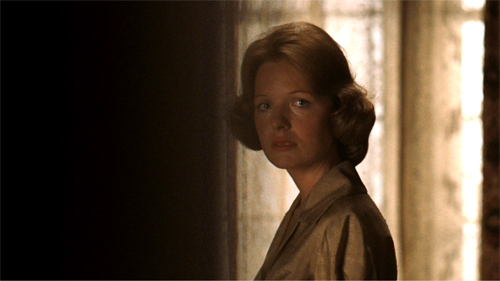
That’s not to say that the film is unproblematically signaling men’s misanthropy. The treatment of Michael’s Sicilian bride Apollonia displays erotic fascination with one conception of naive female beauty, as defined by US culture. (Here again, ideology comes through institutions and iconography.) In other words, social commonplaces are put into play by the dynamic of the overall form. Whenever we say a movie’s cultural resonance is “complicated,” we tend to be saying that various formal pressures are pulling it this way and that. Reflectionism wants a simple flaunting of political views, but form tends to undermine such rigidity.
As a further twist, I’ve argued that the “it’s complicated” cases are themselves strategic maneuvers in having it many ways. Hollywood filmmakers have become adept at presenting mixed messages and heaving the whole thing into our laps for us to sort out. This allows the filmmakers to defend themselves against critiques from many sides while still falling back on the primal cry: “We’re just telling a story.” But this ploy again shows that form is bound by norms, which are mobilized by institutions.
Examples mentioned earlier also try to show how cultural inputs shape artistic form: “Superheroes for Sale,” “Hunting Deplorables, Gathering Themes” and “Zip, zero, Zeitgeist.” Other entries are “Pockets of Utopia: True Stories,” “Welcoming Jews as heroes in alternate 1924 Vienna,” “A24: The studio as auteur,” and Jeff Smith’s masterful dissection of the music cultures informing True Stories, as well as his analyses of Memories of Underdevelopment and Once Upon a Time . . . in Hollywood.”
Crooks in crooked history
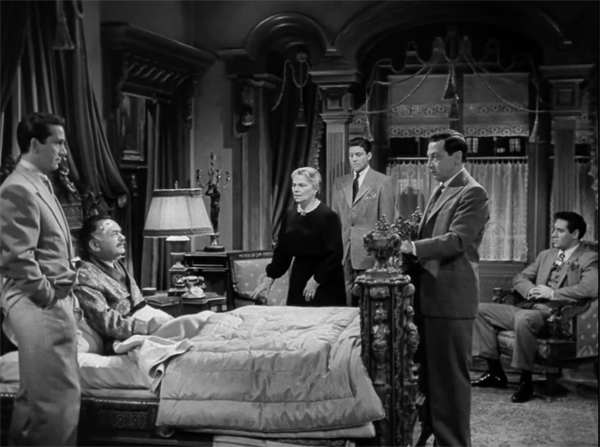
House of Strangers (Mankiewicz, 1949).
Once we admit that we critics are always both “inside” and “outside” the film, institutions have to be acknowledged. Their pressure has been there from the start, in the creation of norms and the setting of platforms and formats. The Formalists were conscious of what they called the “literary milieu,” the ways that social conditions of production and reception shaped the demands put upon writers. If a poem is read in a book, recited in a salon, or declaimed to a crowd, the demands on the poet will vary. A novel published in serialized installments will demand cliff-hanging chapter endings, just like serial TV now.
Milieus of reception constitute subcultures, and these have stronger effects on the work than Culture in general. The subculture of Hollywood favors certain stories and filters out those in circulation that can’t be made to fit. Reciprocally, a work presented in different contexts will encourage audiences to perceive aspects that correspond to their interests. There are as well institutions of reception–megaplex, arthouse, avant-garde venues; critics of various persuasions–and these too make certain aspects of films salient. Watch Rocky Horror Picture Show alone and you’ll notice some pretty square tunes.
Enter history. Early on, Shklovsky saw literary history as a stockpile of devices. Some, such as folktale motifs, were perennial, but others had gone stale and lost their power. An innovative writer could resurrect old techniques and make them seem new. This was the “knight’s move,” the crooked path of history. The son, Shklovsky said, might turn out to resemble not the father but the uncle.
With respect to The Godfather, we might note that while family relations had some role in the classic gangster film, personal ambition seems to have been more dominant. Perverse as it may sound, the domestic tensions and reconciliations of Coppola’s film hark back to the family sagas of the 1930s and 1940s (Four Daughters, A Tree Grows in Brooklyn, I Remember Mama) and the Cain-and-Abel rivalries of the 1950s (Winchester 73, East of Eden). Such a hybrid plot did emerge occasionally, as in the fraternal conflict of the crime family in House of Strangers (1949), but it wasn’t common in the era of The St. Valentine’s Day Massacre (1967) and The Valachi Papers (1972). These films emphasized gang warfare and avoided deep plunges into the personal lives of the hoods. Perhaps House of Strangers is the “uncle” of The Godfather.
The radical Tynianov rejected ideas of influence and tradition as too static. For him, historical change was fluctuating, with the entire literary system altered by innovative works but also by shifts in the milieu. He was particularly concerned with the way writers introduced novelty by incorporating the speech of their time. For him, it seems, the social sphere closest to literature was everyday language; here was where we should look for culture’s impact on form.
In cinema, what is the most pertinent and proximate sphere of culture? My hunch is: other media. The press and adjacent art forms feed into film and provide not only cultural memes but also models of form. In Reinventing Hollywood I suggested that in the 1940s new conceptions of structure and style were borrowed from popular literature, theatre, and radio, and then transformed by film treatment. (Reciprocally, these rival media borrowed from film.) The Godfather provides a modern example, being an adaptation of a bestselling novel that was acclaimed as an insider look at organized crime. Still, Puzo and Coppola took the opportunity of the feature-film format to tighten the book’s plot and heighten the theme of family loyalty, not least because they were pressured not to glamourize cosa nostra and omertà or even use the word “mafia.” Cinematic form and institutional norms shaped the cultural givens that founded the project.
There are several entries considering film form’s relation to other media. The general category is here. A provocative example is Kristin’s “The eyeline match goes way, way back.” See also “Eisenstein makes a scene,” “Watching a movie, page by page,” “Beach blanket ballads: SUN & SEA (MARINA),” and “Who will match the Watchmen?”
My examples from The Godfather don’t add up to an analysis; I used them only as illustrations of how pervasive the principles identified are. The Formalists tried to reveal the general principles that guided verbal artists in their creative choices. We can do the same with cinema. The concepts can become tools for finer-grained study of, as Shklovsky might put it, “how X movie is made.” Not how was it made, in the sense of a production history, but how it’s put together to achieve its effects. One of our entries, on La La Land, is an explicit test run.
“The formal method is fundamentally simple,” Shklovsky wrote. “It’s the return to craft.” This perspective not only promises to heighten our understanding of how movies work and work upon us. It also gives us more respect for the skills of the makers. One reason, we think, that working screenwriters and directors sometimes thank us for our writing is that we try to take account of the creative decisions they make, while still considering their choices in a broader historical frame of reference.
Thanks to Noël Carroll for comments on this entry.
Meir Sternberg’s careful critique and revision of Russian Formalism is laid out in Expositional Modes and Temporal Modes in Fiction.
Kristin called her version of Formalism “Neoformalism.” See Breaking the Glass Armor: Neoformalist Film Analysis. I’ve proposed my own variant as a “poetics of cinema.” See Poetics of Cinema and Ozu and the Poetics of Cinema. Both of us are somewhat more functionalist than Shklovsky. Formalist ideas feature in all of my books, not least the forthcoming Perplexing Plots: Popular Storytelling and the Poetics of Murder. Oooh, scary, huh?
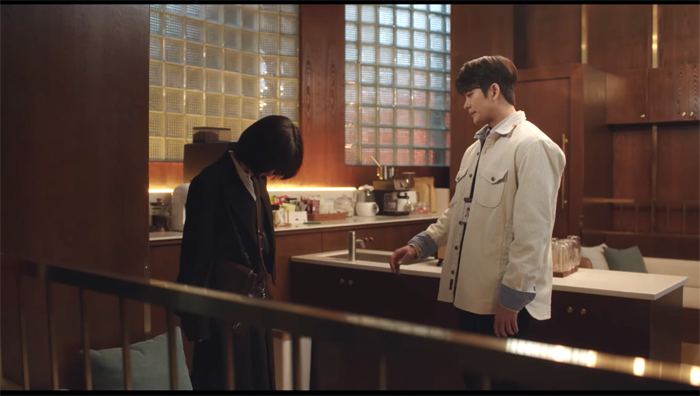
Extraordinary Attorney Woo (2022).
Posted in Critics: Shklovsky, Directors: Coppola |  open printable version
| Comments Off on You say “formalism” like it’s a bad thing open printable version
| Comments Off on You say “formalism” like it’s a bad thing
Monday | October 10, 2022
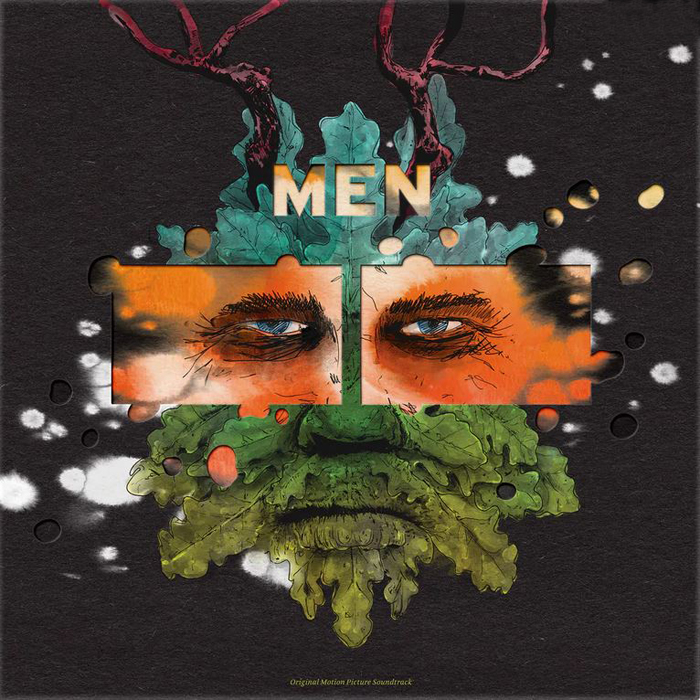
Kristin here:
Regular readers of this blog may remember that back in early May I posted an entry trying to answer, at least to my own satisfaction, the question “How did ‘prestige horror’ come about?” As I wrote at the time, the piece wasn’t motivated by any particular interest in the horror genre. Instead it resulted from the confluence of three films considered to be in that category being released during the summer season: The Northman, Men, and Nope, all by interesting directors. That’s when I discovered the phenomenon of prestige horror as a trope among reviewers. I also discovered that the indie producer-distributor A24 has been a major contributor to the small group of films usually mentioned when anyone writes about prestige horror. (For a good summary of A24’s impact on the horror genre, see here.)
Later, having seen A24’s next release, Alex Garland’s Men and quite liked it, I read some uncomprehending and dismissive reviews of it. (These were largely from mainstream critics; horror buffs who wrote about it tended to “get it.”) I decided to analyze this challenging film and posted the result here.
Two days before Men was released on May 20, Variety Intelligence Platform posted an article by Kaare Eriksen, “Can A24 sustain its box office boom?” (This specialty wing of Variety is behind a pay wall; for those who subscribe, find it here.) Everything Everywhere All at Once was already about six weeks into its unexpectedly lucrative run. Eriksen commented of A24, “Its next film, ‘Men,’ which releases nationwide on Friday, may extend this momentum.”
Not surprisingly, Men did not extend that momentum. As Eriksen points out, it was made on a small budget–though how small we don’t know, as I have seen no figures on the cost of the production. Its worldwide gross of a little over $11 million seems unlikely to have made it even slightly profitable. It appeared on streaming services not long after the film went out of theatrical circulation, which was not typical of A24’s approach. Ordinarily they have left a longer window between theatrical and streaming. Men quickly became available as VOD from several services. How much it made in that fashion is unknown.
I wondered how much impact the failure of Men would have on A24’s financial well-being and decided to find out. It turns out, not much. Perhaps the studio’s head will move away from prestige horror a bit, but A24 was never a specialist in horror in the way Blumhouse is. A24’s films have ranged from high-profile Oscar winners like Room and Moonlight to the modest animated feature Marcel the Shell with Shoes on (bottom). It isn’t shying away from more conventional horror films as the recent releases of X, Bodies, Bodies, Bodies, and Pearl show.
[October 31: Will Pearl boost Ti West’s series into the prestige horror category? (The series will become a trilogy with MaXXXine.) As with Ari Astra’s films, Martin Scorsese has again gained A24 attention by describing his reaction to Pearl: “I was enthralled, then disturbed, then so unsettled that I had trouble getting to sleep. But I couldn’t stop watching.” Several news outlets covered his laudatory remarks.]
Festivals and awards
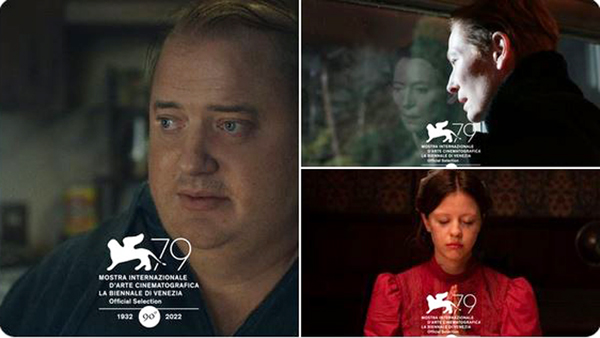
There’s nothing like a premiere at a major film festival or the bestowal of a big award to signal prestige. I mentioned in my prestige-horror piece that A24 had films in that sub-genre premiere at SXSW (Ex Machina, which also won a visual effects Oscar) and Sundance (The Witch). This year the studio took a leap upward with three films premiering at the Venice International Film Festival (above, from A24’s twitter page). Two were in competition: The Whale, by Darren Aronofsky, and The Eternal Daughter, by Joanna Hogg. One premiered out of competition: Pearl, by Ti West, an origin story for and sequel to X (2022).
Festival director Alberto Barbera, asked about blockbuster films at this year’s festival, said: “We had discussions with all the studios. There wasn’t really a blockbuster similar to Joker or Dune, but we still have great presence from the U.S. studios: WB, Sony, Searchlight, Universal, Netflix, Amazon. And for the first time we have two films from A24. I’m really glad we could make it work with them and hope it’s the first of many collaborations.” Barbera is presumably talking about the number of films in competition. Apparently he is anticipating future A24 films on upcoming programs. None of A24’s films won an award at the festival, though one result was that Brendan Fraser has joined the Oscar buzz for a best-actor nomination.
A24’s The Inspection, a film about a gay Black man determined to join the Marines, was chosen as the closing film at the New York Film Festival on October 14.
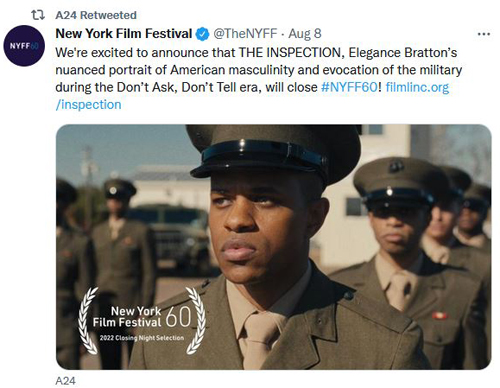
It has already played at the Toronto Film Festival.
Will A24 feature among the Oscar nominees? “In Hollywood it’s never too early to start thinking about the Oscars,” as Clayton Davis wrote in a July 28, 2022 article, “Award Season Preview: Despite Industry Changes, Winning Oscars Remains Top Studio Priority.” Studio by studio, he comments on their chances for nominations:
There’s already a pair of populist contenders in Paramount’s blockbuster “Top Gun: Maverick” and A24’s metaverse action-dramedy “Everything Everywhere All at Once,” which have cemented themselves in the best picture discussion.[…] With “Everything Everywhere All at Once” becoming the highest-grossing film in the history of independent studio A24, they may have more capital to play with to get Michelle Yeoh an overdue nomination for best actress. They’ll also give a qualifying run to “The Whale” from “Black Swan” (2010) by Oscar-nominated director Darren Aronofsky, said to have the comeback performance of the year from Brendan Fraser. They’re also partnering with Apple Original Films once again for “Causeway,” formerly “Red, White and Water” from Lila Neugebauer and starring Jennifer Lawrence, who also produces.
Having already started lists of predictions for the top Oscar contenders, Davis puts Everything Everywhere All at Once at number 6 for best picture. (Davis includes films yet to premiere, especially at Toronto.) Michelle Yeoh tops his best-actress category.
[November 4, 2022: Variety‘s Cynthia Littleton has this to say in a recent story on The Whale‘s Oscar chances: “A24, which is releasing ‘The Whale’ in theaters, is known for the NYC swagger that befits a top indie distributor.”]
[December 3, 2022 A24’s films won four awards from the New York Film Critics Circle awards, the highest number won by any studio.]
Other signs of continued prestige include a brief weekly series called “Post-Horror Summer Nights” that recently ran at the Barbicon in London. Two of the four films were from A24: The Witch and Hereditary. Also, A24 has picked up the North American distribution for Close, Lukas Ohont’s Grand Prix winner at Cannes this year.
The brand
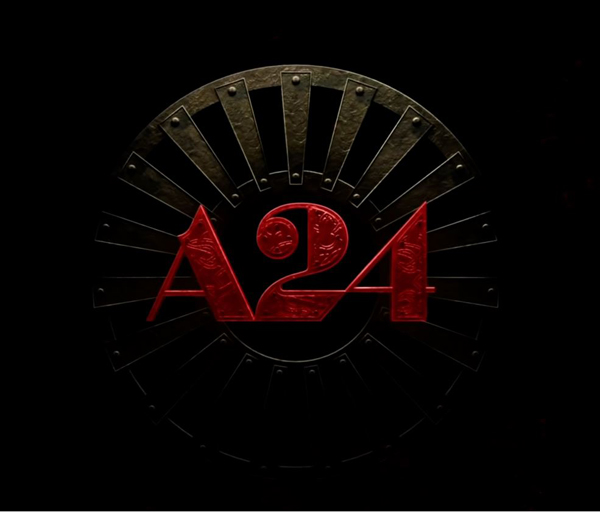
A24 probably is the most widely recognized indie studio. It has its own devoted fans, many of them in that younger demographic so beloved of movie producers and exhibitors. It works hard to maintain that brand recognition. Naturally it has its own Facebook and twitter pages and is undoubtedly elsewhere on social media sites I ignore. It also has a podcast. It re-designs its logo in eye-catching ways to fit each film, as with the Green Knight opener above.
A24 has its own line of merchandising, selling limited-edition items. Some bear its logo and others relate to specific films.
 
As the notes in these examples indicate, the majority of items on the shop page are sold out.
Blu-rays of some of their films, often in fancy collectors’ editions, are available. There are soundtracks as well, only on vinyl. A red-vinyl release of the Men soundtrack with a slipcase “featuring six interchangeable covers with watercolors by Julian Gross” (top). It is not shipping until December, so it’s an iffy choice for a Christmas gift. It’s also apparently the only option if you want the soundtrack on physical media; it is otherwise available only for download.
The items are fairly pricey, though I doubt they affect the studio’s bottom line much. Nevertheless, I suspect that they give fans a feeling of connection with A24 and endow it with a quirky aura that fixes it in people’s minds.
Since they are only sold through the studio’s own shop, at least all the income goes to A24 and not to amazon. Theoretically, that is. Someone bought up a batch of the Green Knight vinyl track (green, naturally), which is now sold out on A24’s shop. That entrepreneur is currently selling them through amazon for $99. The soundtracks originally cost $35 from A24. I guess this is another indication of prestige or at least fan devotion among people potentially willing to purchase a copy despite the considerable markup.
The devotion seems genuinely to be there. In a conversation about “The A24 Effect,” Sam Sanders and Nate Jones are discussing the studio’s skill at marketing films and creating a brand through merchandising:
SS: How much of that is the merch? I don’t think I’ve ever experienced a movie studio in which people in my circles are actually excited about the merch. One of my friends yesterday was raving about his A24 fleece. […] What is that?
NJ: That’s a very big part of it. No one’s walking around in a Focus Features hoodie the way that they are in A24 stuff. It goes back to the marketing, the realization that plugging into these downtown fashion circles is another way to cut through the noise. And they do these limited-edition drops that create this sense of exclusivity that mirrors the way that these films are so treated in the cultural conversation.
Sanders calls A24 “the coolest movie studio around.” The “special recipe” they detect consists of three strands: youth culture, horror, and “auteur-prestige cinema,” such as Room, Lady Bird, and Moonlight.
The finances

Despite the unfortunate failure of Men, A24 is doing quite well.
For one thing, on August 1, HBO Max recently added 28 films from A24 to its offerings, mostly films the company only distributed in its early years. Variety predicts that this list will grow as the studio’s deals with Apple+ and Showtime expire.
More importantly, A24 is expanding based on new investments. On September 1, The Economist took note in an article entitled “The Rise and Rise of A24” (behind a pay wall):
The bosses of A24 declined to talk on the record, coyly hoping their output speaks for itself. It has proved persuasive to financiers as well as awards juries. In March the company was valued at $2.5bn as it took in $225m in investment; the lead investor is Stripes, a private-equity firm that helps businesses grow. The funds will let A24 boost its production capacity. It has opened an office in London (and poached two BBC commissioners); it hopes to make films and TV programmes in other territories soon, possibly in foreign languages.
In Erikson’s “Can A24 Sustain Its Box Office Boom?” (linked above), he mentioned “A24’s reported exploration of a $2.5 billion to $3 billion sale last year, with newer streaming entrant Apple apparently interested at one point. This apparently was a result of the pandemic-related slump rather than any underlying vulnerability on A24’s part.
In another symptom of financial health, in October 2021, A24 signed a 15-year lease on four floors of a major new office building at 1245 Broadway. This building was just finished last month. I presume the studio will soon transfer its headquarters from its current modest headquarters, one floor in 31 West 27th Street, to which it moved in 2015 (above). Given the rather bare-bones appearance of the current office, I presume this is a considerable expansion and a more prestigious location. A24 seems confident that it will be around for quite some time.
I am not a fan of the studio itself, only some of the films it has made. Apparently a common accusation leveled against A24 is that it is pretentious, or its films are, or its fans are. But “pretentious” is a word used freely, depending on the tastes of the person using it. Many of the great filmmakers of cinema history are thought of as pretentious by some. The strengths of A24 are that it is surviving in an industry context where films with modest budgets are struggling in the theatrical market and franchise films dominate. In the same “The A24 Effect” podcast linked above, critic Alison Willmore points out that the studio owns no intellectual property that has generated a franchise and that its films are mostly originals or based on fairly obscure literary sources. This helps account for the considerable variety in the types of films A24 releases. It is good to see an indie studio managing to survive and even thrive these days.

Marcell the Shell with Shoes on (2022)
Posted in Hollywood: The business, Independent American film |  open printable version
| Comments Off on A24: the studio as auteur open printable version
| Comments Off on A24: the studio as auteur
Monday | September 26, 2022
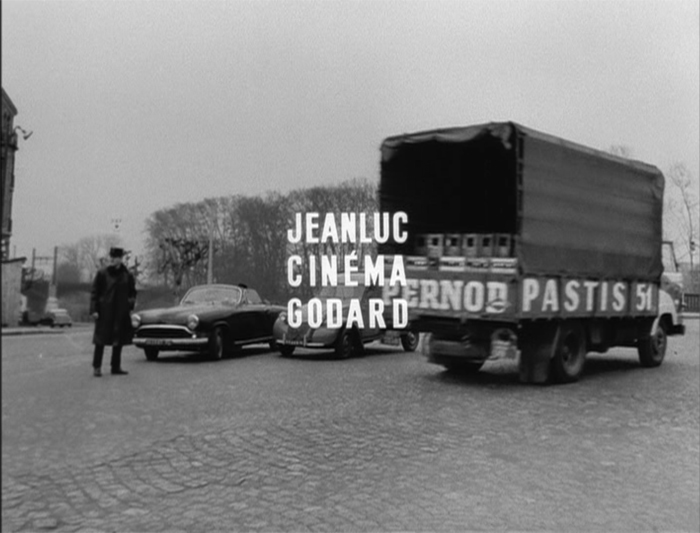
Opening credits of Bande à part (1963).
DB here:
He was a sketchy fellow, to put it mildly. Childhood episodes of theft were followed by larceny as an adult, when he stole his grandfather’s Renoir and swiped cash from the Cahiers du cinéma till. Notorious for taking funding for projects that were never made, he once contracted for $500,000 to create a film on the Museum of Modern Art. He declined to visit the museum and instead shot the footage from stills at home. When The Old Place was finished, he agreed to introduce it in Manhattan. Hours before he was about to fly out (on the Concorde) he canceled, using anti-American cinephilia as his excuse: “I will return to New York when the films of Kiarostami are playing on Broadway.”
He liked to fight. Friends, romantic partners, performers, producers, government officials, and critics all felt his wrath. Jane Fonda was the target of Letter to Jane, a critique of a photograph of her meeting the North Vietnamese. The voice-over narration insisted it was not an attack on her as a person but as a “star.” Breaking with Truffaut led Godard not only to harangue his former pal (“liar”) and the films he made, but demand money so that he could make a film in response to Day for Night. Truffaut’s twenty-page reply called him “a piece of shit on a pedestal.” They never spoke again, and Godard’s remarks after Truffaut’s death praised him as a critic but omitted mention of his films.
Meeting Professor Pluggy
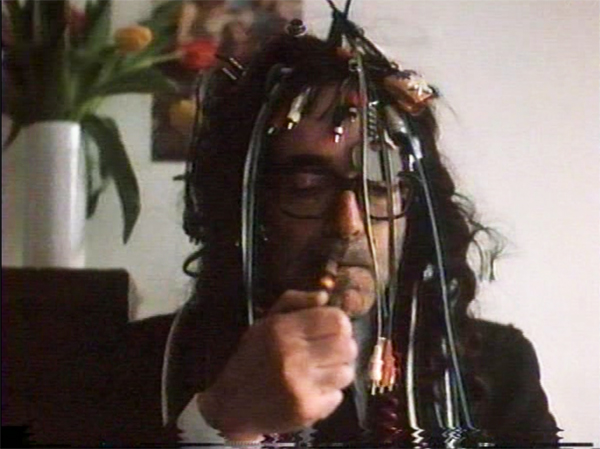
King Lear (1987).
I never had an abrasive encounter with Godard, but I always sensed that he was aloof at best. My first, very brief meeting was in spring of 1973 when he and Jean-Pierre Gorin visited the University of Iowa with Tout va bien (1972). Onstage, he was calm and earnest, while saying fairly provocative things. (Go here for a record of one session.) Asked what he thought of The Godfather, he replied: “The Godfather is shit. But there is a part of me that loves shit.” My eyewitness encounter took place in an elevator, when the host told Godard and Gorin that their schedule now had an empty hour. Godard said: “I am a prostitute. Why do you not use me?”
I had more prolonged exposure to him in 1981, when he visited a lecture series I was giving at the Walker Art Center in Minneapolis. He was touring with Sauve qui peut (la vie) (1980), and the series director Melinda Ward took the opportunity for us to do a career review onstage. I planned to juxtapose clips from his work with those by other directors, and called him at Rolle to review my choices. He listened politely and said they would be fine, adding: “No matter what you choose, it always works.”
The session turned out well, with Godard modest about his efforts compared to those of Preminger (“like Manet”) and others. The only time the audience seemed ruffled was when he said of Jerry Lewis and the clip from The Ladies’ Man: “He is Robert Rauschenberg” (seems reasonable). For a couple of days Kristin and I drove him to interviews around town, and he spent his time reading Variety, noting only that he was pleased that Gance’s Napoleon was doing good business. Attempts to engage him in conversation were fruitless. But once onstage he was alert and genial, all soft speaking and gentle smiles.
The big stir came the following night with the screening of Sauve qui peut. A considerable portion of the audience objected to the film’s sexual politics. The most fraught moment, as I recall it, went like this:
Woman in the audience: Why do you make films only about women prostitutes, not male ones?
JLG (after a pause): They are different things.
Woman: How can you claim to talk about a women prostitute’s life?
JLG: Well, every time I hire a prostitute I ask her about her experiences.
Audience: stunned silence.
My last encounter was the most embarrassing. Invited to a conference on his work at Liège in 1986, I had horrible jet lag. In the first evening, a Q & A with the master, I made the mistake of sitting, as usual, in the front row. The problem was I kept dropping off to sleep. Every time I blinked awake, Godard was staring impassively at me. I thought no one noticed, but afterward one of the conference speakers said: “He was looking at you sleeping all the time.” Jesus.
I consider myself lucky to have escaped the treatment others have reported. Maybe it made it easier for me to admire his work. Yet even that admiration is tempered by exasperation. Bypassing von Stroheim and Buñuel, he might be the most annoying great filmmaker of all.
I’m not referring just to his obsession with female nudity, or his pretentious wordplay, or his pseudo-profundity. His provocation goes all the way down to the very texture of the film. In form and style he embraced irregularity. He will create a scene that’s conventionally beautiful, only to spoil it with a harsh disjunction or a silly gag or a deflating commentary. He seems to want to coax us to enjoy imperfection. His deformations of story and style are the result of testing the limits of what cinema had done, and might do.
Early work: Puncturing the plot
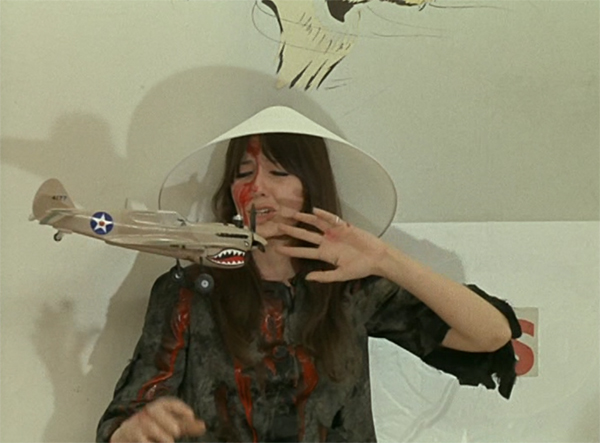
La Chinoise (1967).
Everything about him is troublesome. As a rough approximation, we tend to divide Godard’s career into three parts, but the results are peculiar. The early New Wave period runs from 1959 to 1967. The second, his overtly “agitprop” phase runs until 1980. Then we have “late Godard,” which dates from Sauve qui peut (la vie) until his death this year. What other artist has a “late” period running over forty years?
In all these periods, it’s common to say that Godard attacked, even destroyed, previous forms of cinema. But it helps to specify a bit more. I want to focus on his peculiar relation to narrative.
He often derided Hollywood’s reliance on stories, but throughout his career he depended on them. Asked about Hail Mary, he replied that the Bible had many good stories one could use. The project he proposed to Coppola about Bugsy Siegel and the founding of Las Vegas was initially titled simply “The Story.” Even the collage form he utilized in his last completed film, The Image Book, ends with a fictional tale about how Sheikh Ben Kadem, ruler of a kingdom called Dofa, tried to resist American imperialism.
One reason his early work succeeded, and survives as a body of classics, is that he relied on narrative conventions of traditional filmmaking. He rummaged through familiar genres: the couple on the run (Breathless, Pierrot le fou), spy intrigue (Le petit soldat), musical comedy (Une femme est une femme), social drama (Vivre sa vie, Two or Things I Know about Her), war picture (Les carabiniers), marital drama (Contempt, Une femme mariée), a robbery scheme (Band of Outsiders), a detective investigation (Alphaville, Made in U.S.A), and young romance (Masculin féminin).
More radically than his New Wave colleagues, Godard transforms these conventions. Sometimes he de-dramatizes intense situations, as in the violence of Le petit soldat and Les carabiniers. More commonly, he punctures the stories with digressions, skits, and uncertainties about character psychology. There’s also often a mockery of the very conventions invoked. Nonetheless the genres provide an armature for the audience to cling to, and the plots wrap up with more or less decisive endings.
With La Chinoise, not only does the plot swerve from traditional genres (I suppose it’s a perverse roommate-relationships story) but the dynamic of the drama becomes overtly rhetorical, with both the characters and the overall narration setting out political theses. Weekend has a narrative core–a couple set out to visit and kill a rich relative–but the familiar journey schema becomes apocalyptic as the bourgeois encounter a world bent on revenge for oppression.
One strategy Godard pursues is to deform narrative by mixing in other formal principles. The later early films introduce passages cast in rhetorical form, as when characters indulge in extensive arguments about philosophy or politics (La Chinoise, Vivre sa vie).
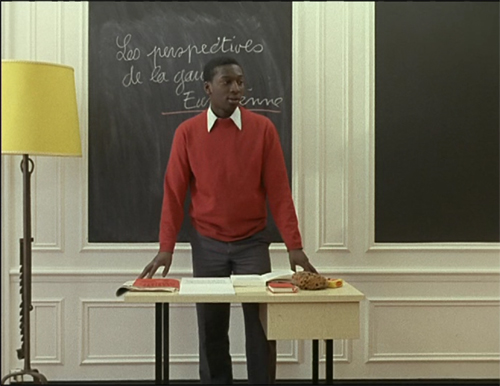 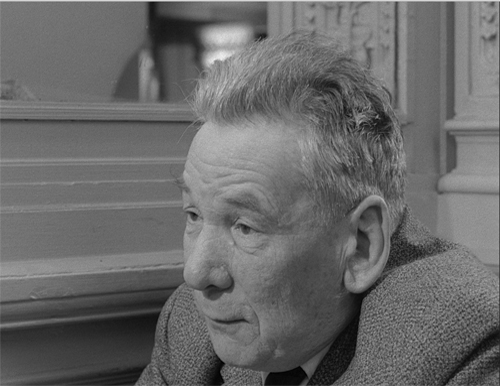
The early work also introduces passages of associational form. More and more often, Godard interrupts the action with cutaways to images that create commentary, analogies, and contrasts. Book titles are the simplest examples, but we also get the shots of fashion advertising interpolated into Une femme mariée and the landscape of consumer goods inserted into Two or Three Things.
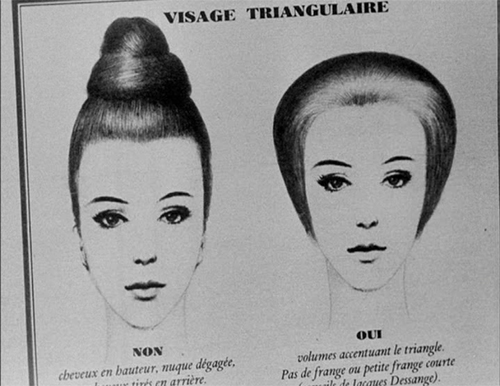

With Le gai savoir of 1968, narrative is sidelined altogether as the primary characters conduct a political deciphering of a cascade of mass-media images.
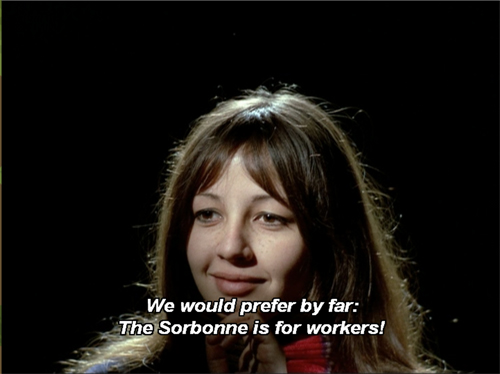 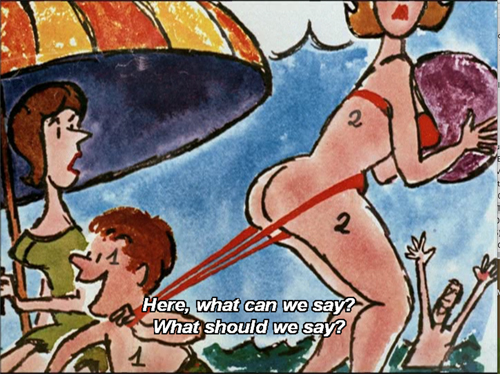
The late 1960s-early 1970s quasi-Maoist films that Godard made with Jean-Pierre Gorin, sometimes under the rubric of the Dziga Vertov group, rely mostly on rhetorical and associational form, as in One Plus One and Pravda. Vladimir and Rosa, however, returns to narrative in providing a caricatural replay of the trial of the Chicago Eight, and Tout va bien is like the early work in embedding its political commentary in a more or less linear plot line.
After the break with Gorin, Godard continued to mix narrative and other formal options in Numéro deux, Ici et ailleurs, and several striking documentaries of the mid-1970s. Seen today, Comment ça va looks ahead to both the style and the construction of his late films in tracing two couples caught up in the politics of the mass media.
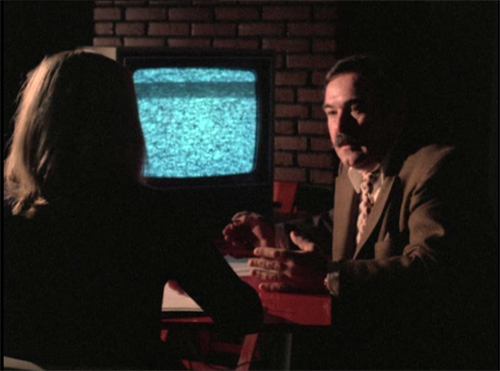 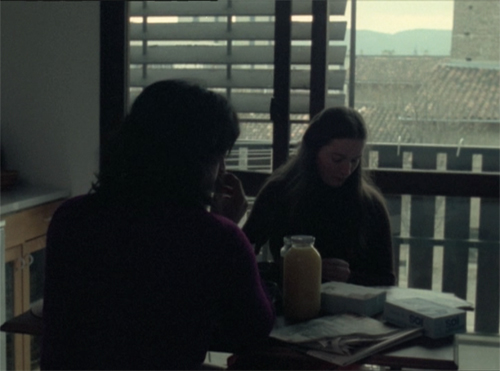
Style as rewriting

JLG par JLG (1995).
By emphasizing Godard’s reliance on narrative principles I don’t mean to reduce his originality. Like a Cubist painter creating a portrait or a still life, he needs some norms in order to introduce his disturbing deformations. He gives with one hand and takes away with the other, and to feel his work’s disruptive force we need a tacit background of what’s ordinarily done.
The same holds for matters of style. Most scenes in the early films rely on standard continuity, as I tried to show in one chapter of Narration in the Fiction Film. Even a film as fragmentary as Vladimir and Rosa depends on eyeline-match cutting.
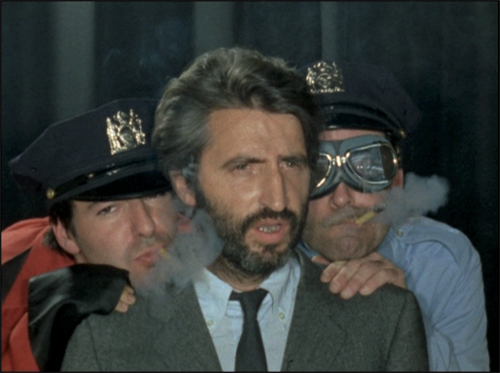 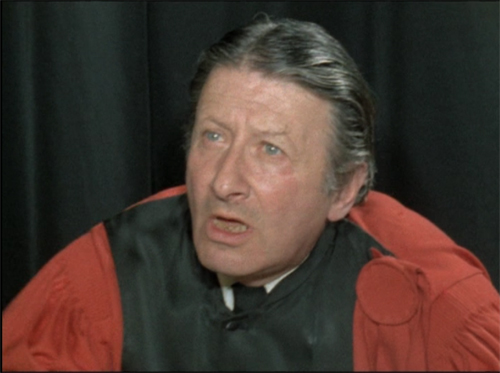
Godard’s limited obedience to standard style makes the deviations stand out. In the shots above, the curtain background forestalls expectations of real space. Often the calculated disruptions of continuity have an arbitrary air, as if there’s no particular motivation except the opportunity to try something new. The celebrated jump cuts in Breathless, for example, seem to have no specific functions as motifs or narrative cues. They register as glitches, gratuitously spoiling a shot. Like DJ scratches and skips in hip hop, they come to form percussive passages that can be appreciated for themselves.
The early films try everything: labyrinthine camera movements, shots too short to be grasped, abrupt dropouts of sound and image, wisps of voice-over. Drama could be punctured or entirely suppressed. Alphaville expands a moment of suspense into a lyrical interlude, while Un petit soldat, after arousing our concern for the woman the hero meets, shoves her torture and death offscreen, reported in a tossed-off line of dialogue. All of cinema was simultaneously available to the New Wave directors, who at Langlois’ Cinémathèque saw a Griffith film alongside a Nicholas Ray picture. Godard gleefully ransacked film history, while deforming each device to see what he could make of it.
For example, Godard gave new life to a compositional option I’ve called planimetric framing. The camera shoots figures perpendicular to the background and places those figures frontally or in profile. Earlier it had been an almost ephemeral moment. Godard makes it a stylizing gesture, offering pictorial abstraction that short-circuits naturalistic drama (Pierrot le fou, Two or Three Things I Know about Her, Vladimir and Rosa).
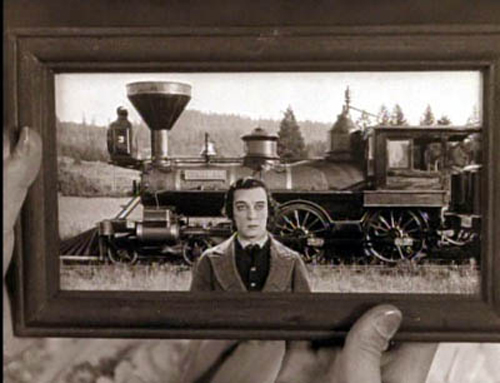
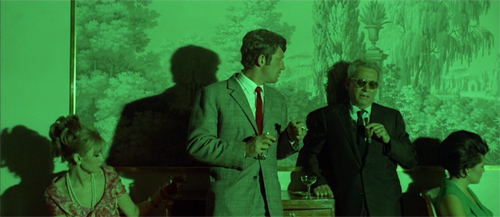

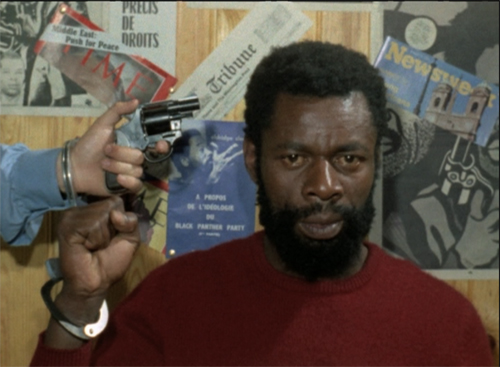
What binds these all stylistic tactics together, I think is a broader narrational strategy. Godard carries the auteur theory to a new limit. In watching the film, we become aware not just of “a narrator” but of a specific agent, Godard the director, who insists that his story world is created and transformed by the practices of cinema. This isn’t just “Brechtian” distancing but persistent signs of this particular filmmaker’s creative work. Godard invites us to admire his sometimes annoying audacity.
The intertitles are the most evident signs of this agent’s activity, but so too are the unrealistic staging, the abstract compositions, the geometric camera movements, and especially the manipulations created in post-production. Sound mixing cuts off noises, muffles dialogue, provides anonymous voice-overs, scatters audio across many channels, and wedges in chunks of music. Post-production is seen as offering the filmmaker’s final, if sometimes inconclusive, revisions of his creation. It’s as if a novel were published as the copy-edited and marked up proofs of the author’s manuscript.
Critics are fond of saying that 1960s Godard changed the language of cinema. That’s sort of true, but we should remember things that were abrasive or alluring in his films have mostly been tamed by their assimilation to mainstream uses. Chapter breaks and intertitles are now recruited to create coherent story connections, as in Tarantino. The handheld camera is commonplace, but it serves chiefly as a wavering substitute for standard framing. His planimetric framings create a painterly abstraction, but in the hands of Wes Anderson they function as seriocomic establishing shots. Today’s directors use jump cuts mostly to compress time between stages of an action, not to annoyingly break the flow. And even our filmmakers who treat auteurism as a brand do not create the sense of the filmmaker’s hand fooling with every image and sound on the fly. Godard’s unpredictable tweaking asks us to adjust to a film that will undercut its own effects.
It makes me revert to a quotation I’ve used before. Supposedly Picasso told Gertrude Stein: “You do something new and then someone comes along and makes it pretty.” It’s worth noting that as mainstream films adopted his early technical tics, Godard abandoned most of them. His later work locks down the camera, favors depth staging over planimetric flatness, and avoids jump cuts. Three separate, disjunctive shots in Hélas pour moi show how he can reinvent continuity jumps, this time to harshly italicize a gesture: departure.
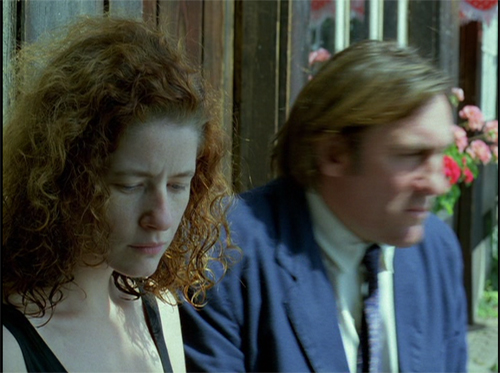 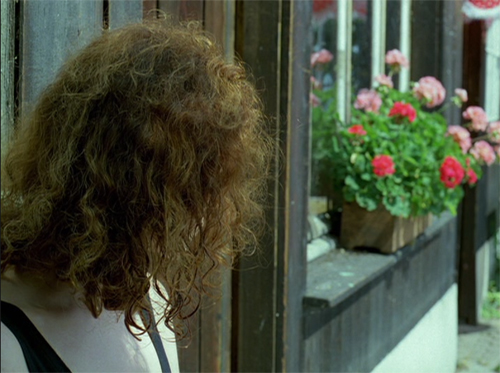 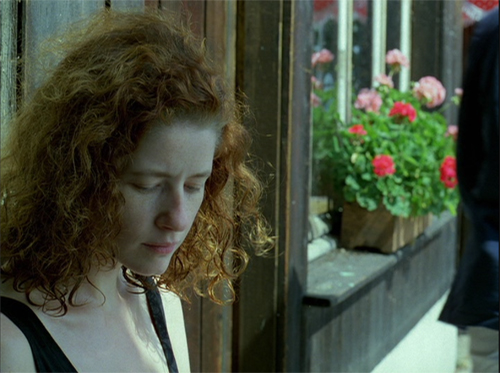
Late films: What the hell is going on?
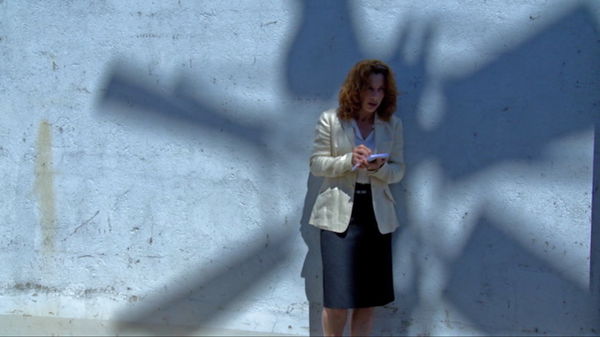
Film Socialisme (2010).
The late films of Godard are tremendously varied, and I can’t claim to have seen, let alone assimilated, all the shorts and medium-length projects. But consider just two main types of features. There are the “film essays,” the prototype being Histoire(s) du cinéma (1988-1998). His last feature, The Image Book, is also an instance.
I’m disinclined to call them essays, since the ones I know don’t coherently marshal evidence to support a line of argument. They’re largely associational collages of found footage, suggesting pictorial or conceptual links among them. If you want a literary analogy, the poetry of Whitman or Pound would be close. The collage films also have rhetorical overtones, presenting ideas about, for instance, the way Hollywood evolved after World War II in Histoire(s). In its mixture of rhetorical and associational patterning, Le gai savoir was a rough prototype for the collage films; they simply delete the characters whose dialogue frames a flurry of images and substitute Godard’s own voice, or a merger of other voices.
I’m in that minority of Godardolators who find the collage films of limited interest. I find the philosophizing often facile, the claims about film history too broad, the politics obscure and even naive. Most essays take opposing views seriously enough to confront them, but Godard doesn’t rebut positions. He contents himself with post-production reworking of the imagery, twiddling the knobs to destabilize the image. As in the early films, his documentary images can’t escape transformation by the all-powerful filmmaker. At the least, comments might be scrawled on the images. But there will also be superimpositions, spasmodic slow motion, and freeze frames. Color values are garishly recast and aspect ratios pinched or stretched (Histoire(s), The Image Book).
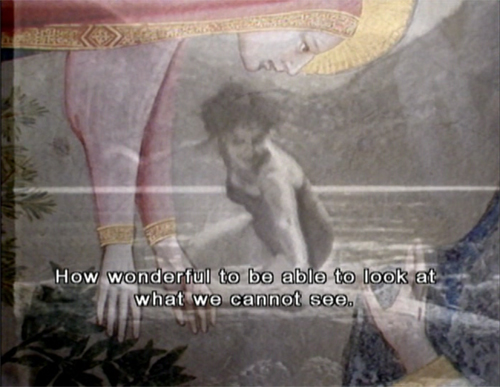
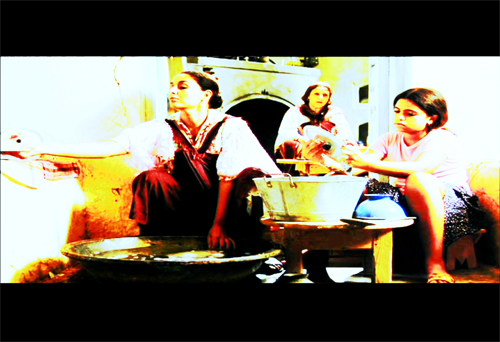
The demiurgic filmmaker can’t leave any picture alone. And of course his voice will guide the soundtrack. Other auteurs have a discreet signature; Professor Pluggy, thanks to all those RCA cables, gives us incessant audio graffiti.
For me the triumphs of the late career are the narrative features. Just as the early films deformed norms of classical storytelling, these can be taken as a continuing dialogue with contemporary “art cinema,” that psychologically-driven filmmaking that explores characters’ minds and relationships. While art-cinema narration sometimes challenges the viewer, Godard goes much further.
Again, story entices us. The late films return to situations he has long relied on, usually involving a romantic couple but sometimes also a family, as in the second section of Film Socialisme. There are recurring arcs of action: seduction and courtship, a dissolving couple, an investigation, or an artistic project–recording a song, making a film. There will be at least one long conversation, but also communication through body language, often violence.
The milieu is often that of a workplace–a factory or business, especially that of prostitution or filmmaking. (Passion makes the film studio a parallel setting to the factory.) Godard once said that the most important things in life are love and work, and these concerns supply his late works’ narratives with a recognizable world.
He sometimes provides “braided” plots, tracing two or or more groups of characters, parallel or intersecting. For Ever Mozart bears the label “36 Characters in Search of History.” Such braiding is comparatively rare in his early period. The plot will be partitioned by chapter divisions, but they don’t necessarily mark off portions of a story; just as often they interrupt a scene. Instead of braiding, we may get a sort of geometry, with two or three side-by-side stories–leaving us to sense connections among them. As the late career progresses, I think that those connections become more elusive.
Once we have narrative conventions in place, they can be blocked. Reviewers who confidently sum up a Godard plot don’t do justice to Godard’s astounding resourcefulness in impeding our understanding while still teasing us to try to get it. If the early films interrupt the action, in the later films we have trouble figuring out what the action is.
Bereft of point-of-view shots, visualized memories and dreams, appointments, and deadlines, these films avoid the commonplaces of modern movie storytelling. In that sense his films are “objective” in relying on characters’ behaviors to convey the action. But that behavior is often difficult to understand.
The characters may be unidentified, or inconsistent, or unrealistic in their actions and reactions. Why does the factory boss in Passion carry a rose in his teeth? Where does the twin of Alain Delon come from in Nouvelle Vague? On first seeing Hélas pour moi, I found every image ravishing and every scene baffling.
The most basic exposition about the characters’ relationships is often suppressed. Often you must watch the film several times to figure out kinship and alliances because there is only one hint, not the redundant signaling we get in mainstream cinema. And even when we’ve sorted out the characters’ roles, a scene may not have a clear-cut arc. We might enter the action partway through and leave it before the scene ends.
Part of the difficulty comes from an idiosyncratic style. He favors “troubled” master shots. The action is given a kind of coverage, but with obscure angles, partial framings, and time gaps between shots (alternatively, repetitions of dialogue). The editing of a scene often relies on the Kuleshov effect, with shots of single characters linked through eyelines.
Overall, a scene’s presentation is both sparse and dense. The action is built out of details, but sometimes things get overbusy, with jammed frames and layers of dialogue. And he loves to block our view of faces, by using the frame to decapitate major characters, or to interpose objects that make it hard to understand who’s present, or to tuck faces into apertures.
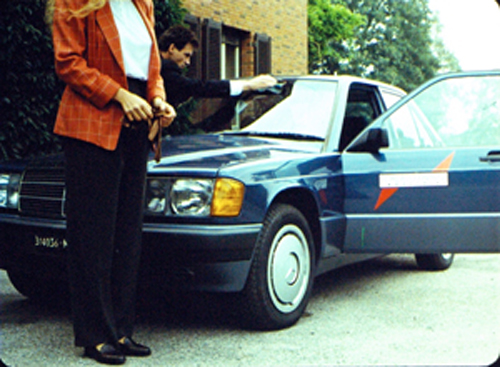 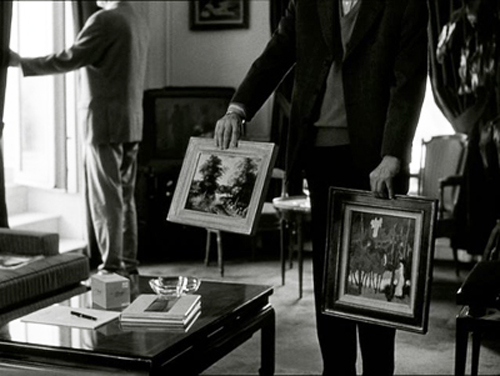
More blockage: main characters are often turned from us, plunged into shadow, or put out of focus, making expressions difficult to read. Combined with depth staging, these shots challenge us to carve out the prime narrative action (Passion, Éloge de l’amour, Notre musique).
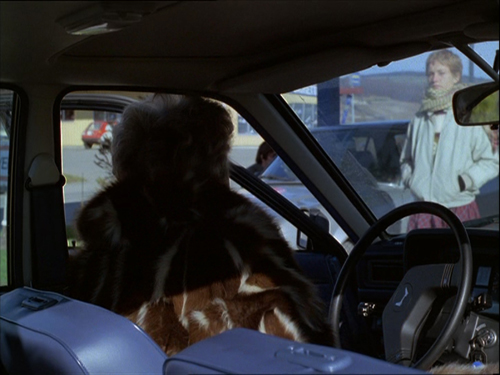
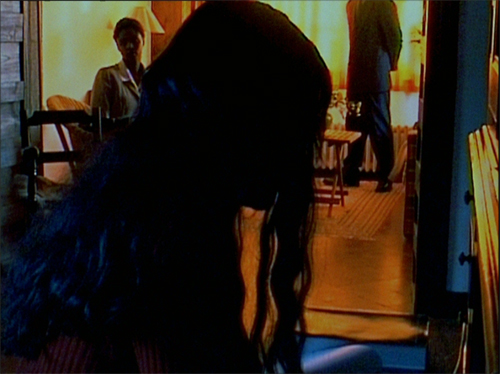
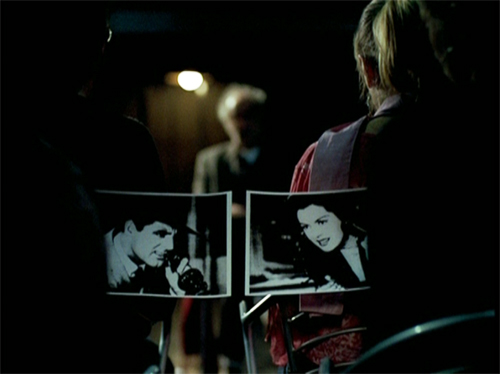
Refusing the Steadicam (and today’s annoying slow track-ins to a character), Godard locks down the camera. He moves his figures through the shot and insists on filling the 1.37 ratio: every zone of space can matter. Any area of the image can harbor a significant gesture or facial expression (Hail Mary, Detective).
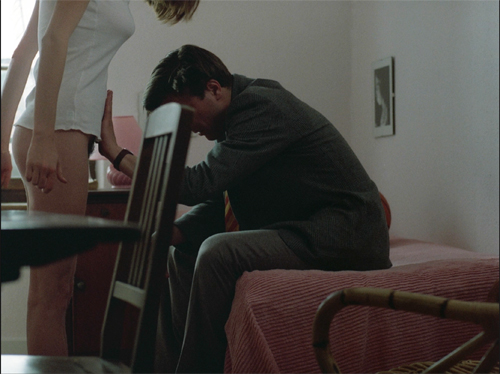 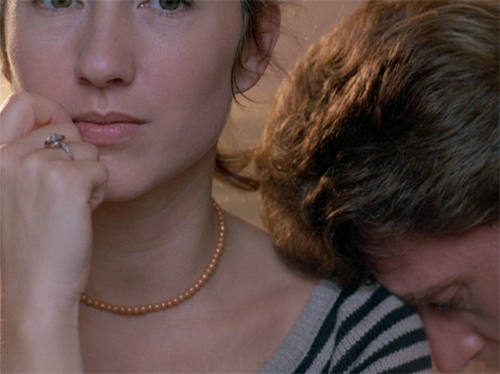
Godard’s fastidious attention to the precise image has not prevented him from his characteristic “overwriting” in post-production. The action, inevitably, is interrupted by intertitles. Classical music or ECM samples drop in and out, with a voice-over elaborating on what we see. Not content to let others supply English subtitles, Godard has lately provided his own, or simply suppressed them during certain stretches of dialogue or voice-over.
One result of this obscurity is to redirect our attention. If we can’t comprehend the full story action, we focus on other things, such as the composition of the image, the interplay of sounds, the expressiveness of the music. Alternatively, the absence of clear-cut scenic structure throws an emphasis onto the texts that his characters obsessively read, cite, and recite. And when we do see clearly, there are the faces, given weight by the shots devoted to them (Notre musique, Allemagne année 90 neuf zéro).
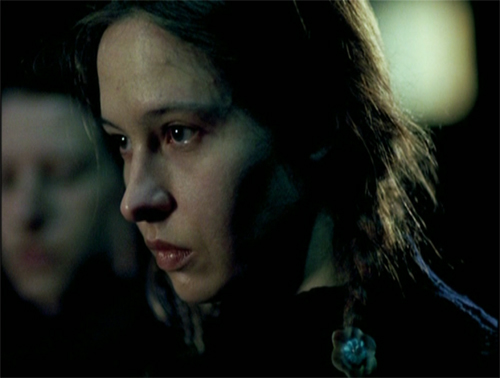
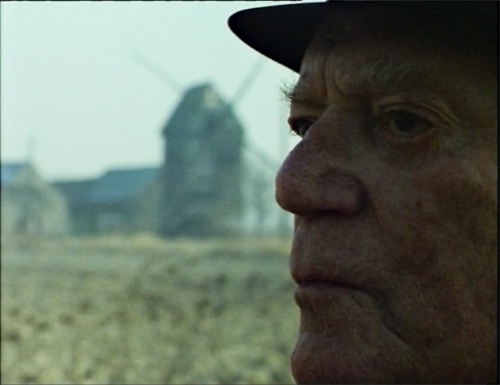
There’s also the historical dimension of the deformations. A Picasso still life asks us to compare it to the classic exemplars of the genre. Similarly, Godard asks us to compare his forms and styles to their precedents. Détective, one of the few late films that hark back to classic Hollywood, proffers a mystery (who killed the Prince two years ago?), investigated by three characters. There’s also suspense, and a deadline for payment during a prizefight. Alongside this noirish premise is a Grand Hotel template juggling several couples and romantic triangles. But this “ensemble film,” packed with opaque shots and fragmented scenes, is far from the trim construction of classical Hollywood.
Similarly, Éloge de l’amour, with its quest to grasp the Holocaust, invites us into an art-cinema investigation plot reminiscent of L’Avventura. But instead of a search for a missing person, we get a dense adventure split into two parts (black and white film, trembling color video) that does what it can to cloud the inquiry, while bringing out a critique of Hollywood’s treatment of history.
“The best criticism of a film is another film.” Taking film history as a conversation among filmmakers, Godard bounces off Rossellini’s Germany Year Zero, Pialat’s Sous le soleil du Satan, and Truffaut’s Man Who Loved Women and Day for Night (below, with Passion).
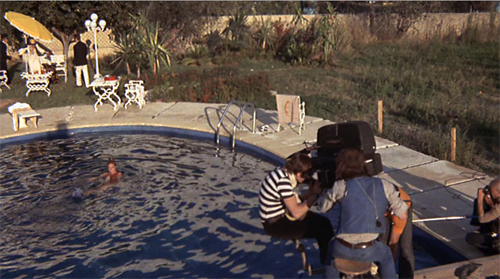
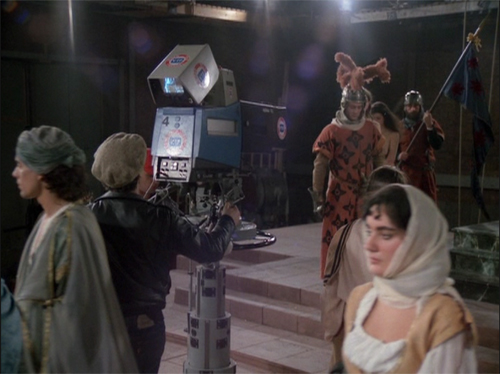
Late Godard has shadowed Tati with distracting long-shot staging reminiscent of Play Time (here, Hélas pour moi) and has paid homage to him in Soigne ta droite.
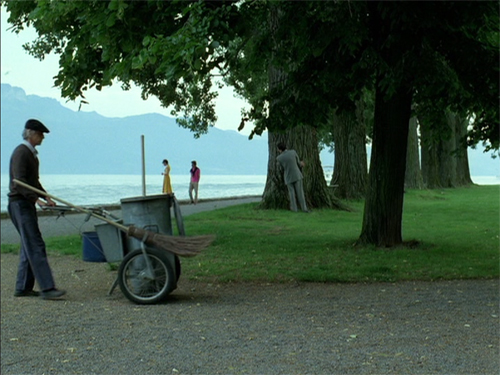

Even more pervasive is the invocation of Bresson. With a behavioral narrative, sound that replaces image, and the fragmentation of a scene through partial views, Godard seems to take a perverse “next step” beyond the master. Bresson died during the shooting of Éloge de l’amour, so there’s of course an homage, but more generally the late films’ style often radicalize Bresson’s technique, hands above all (Soigne ta droit, Détective).
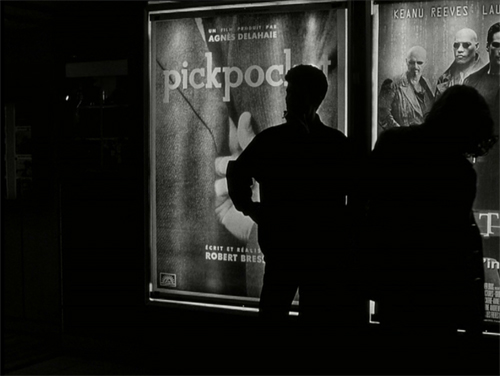
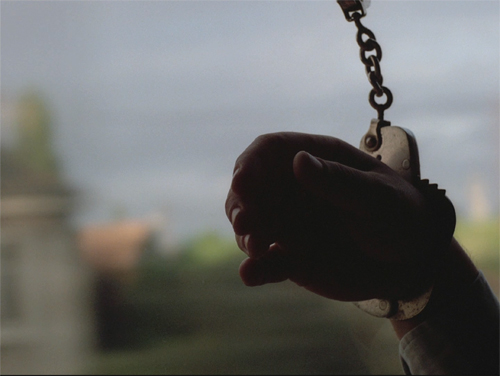 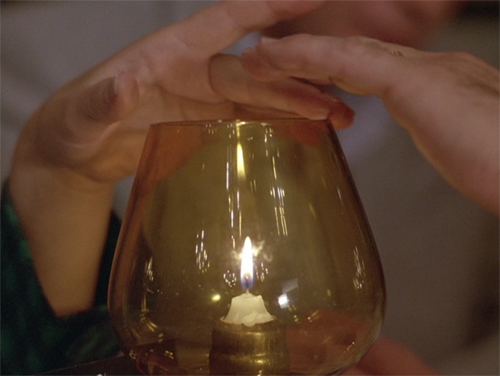
Godard’s deformations not only “spoil” his own work but point to fresh possibilities in the traditions of narrative cinema.
Moments
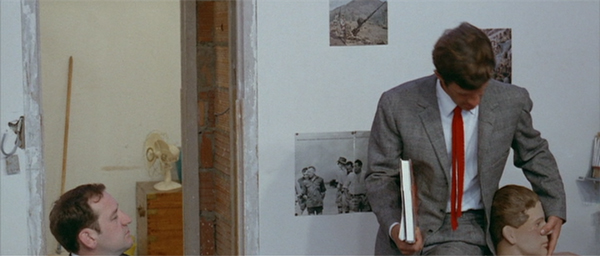
Pierrot le fou (1965).
It’s not enough to note all the ways Godard impairs our comprehension of the story. As critics we need to show how the result can still add up to something coherent, even rigorous. We probably won’t be able to clarify everything, but we can try to show underlying patterns, in the way a critic can show a compositional logic underlying a cubist painting. I’ve tried to do this in two installments of our series on the Criterion Channel and in my analysis of Adieu au langage. Check the codicil to this entry for details.
But even if the overall strategy of disruption remains obscure, there’s a lot to engage us otherwise. Godard has given us scores of shots that no one had ever made before. Here are a few of my favorites, apart from ones I’ve already shown (Une femme mariée, Hail Mary, Made in USA, La Chinoise, Détective).
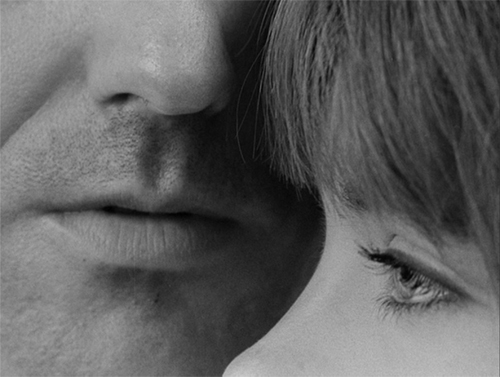

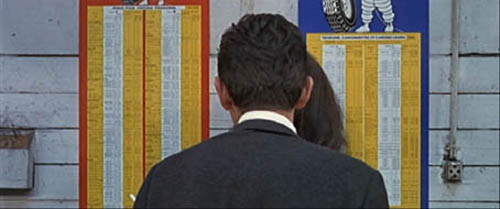
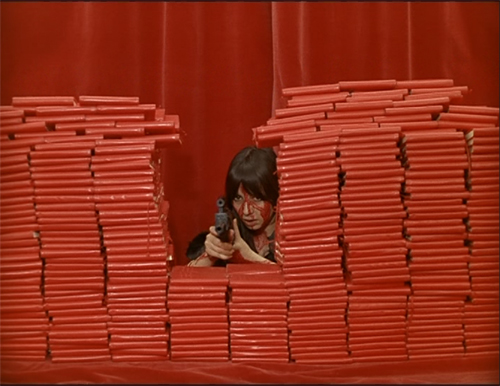
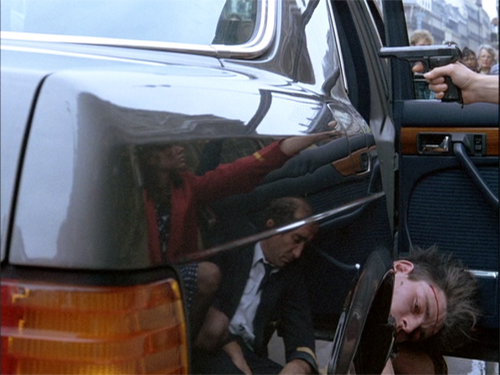
You have your own, I bet.
Given such shots, you can argue that the Godard narrative has been the bait to lure us into savoring privileged moments of cinema. Is this the heritage of Cahiers cinephilia–Godard’s version of “movie moments” that thrill us through what film (and video) can uniquely do? Or are they a refutation of the overblown CGI of Hollywood, showing what kinds of dazzling imagery can be achieved without special effects?
At any rate, such moments are especially resonant in the context of all the uncertainty. In all, we’re left with an aesthetic of exquisite spoilage. Godard teaches us to sense form underneath deformations, while still making imperfection a ripe artistic pleasure.
My references to Godard’s life are drawn from two excellent career accounts, Richard Brody’s Everything Is Cinema: The Working Life of Jean-Luc Godard (Metropolitan, 2008) and Antoine de Baecque, Godard: Biographie (Grasset, 2010). Brody’s exemplifies what a true “critical biography” should be.
On the Criterion Current, David Hudson compiles links to several Godard tributes. Don’t miss David’s own discerning essay here.
For some years I’d thought of writing a little e-book on Godard, complete with clips. (Why not rip him off as he has done with so many others?) But as I’ve aged I recognized that I’m overmatched. Instead, some entries on this site approach him in bite-size chunks. This piece goes into some detail about his preference for the 4:3 ratio, and how video versions in wider format degrade his compositions. Thoughts about his use of Scope in Le Mépris are elaborated in my Criterion Channel installment of Observations on Film Art. Another Criterion Channel commentary considers the use of the classic ratio in Vivre sa vie. Quick remarks about Le petit soldat are here, based on a visit to Belgium’s Summer Film College. (Visit Cinéa and photogénie to survey the vast number of events and critical studies the College has fostered over the years.)
At another session of the College I offered some ideas about the late films, particularly Nouvelle Vague. (And when will a video version give us the proper 1.37 image for this film? Same goes for Sauve qui peut (la vie) and King Lear.) This entry looks at Godard’s use of Bressonian editing in Hail Mary. Kristin offers a contextual analysis of Film Socialisme, with close consideration of the controversial subtitles. Earlier she took it as an example of the sort of film arthouses should be committed to screening. My comments on that film are here. At the Vancouver film festival KT and I saw 3 x 3D and offered some comments. One entry on Adieu au langage traces some of his 3D tactics, while another considers this film in relation to other late features and offers a detailed analysis of the film’s opening. These essays were revised into the Kino Lorber DVD liner notes.
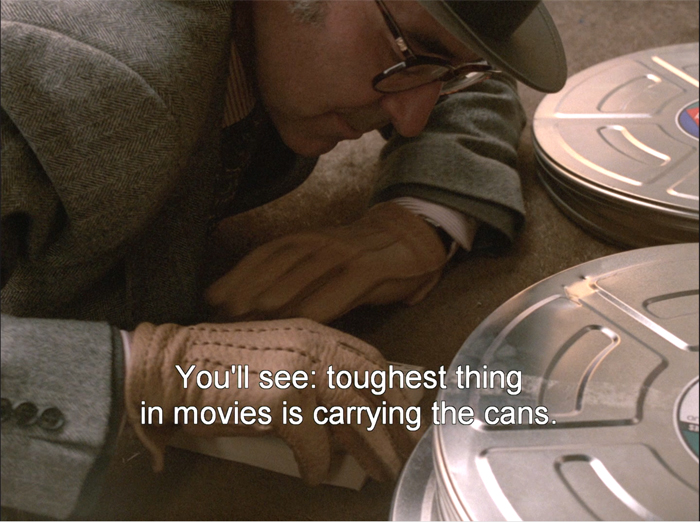
Soigne ta droit (1987).
Posted in Directors: Godard, Film technique, Narrative strategies |  open printable version
| Comments Off on Godard: The power of imperfection open printable version
| Comments Off on Godard: The power of imperfection
Monday | September 5, 2022
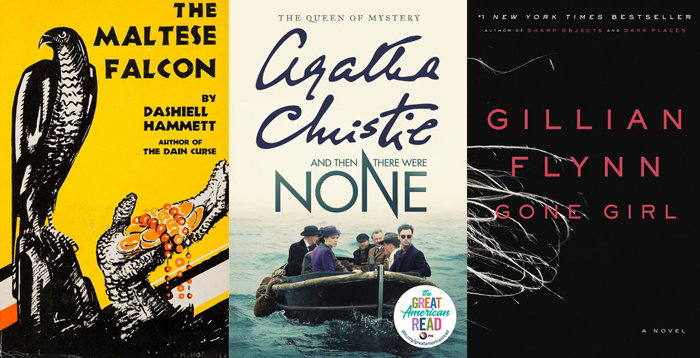
DB here:
In my early teens I bought murder mysteries from the legendary Claude Held of Buffalo. Lacking a checking account, I blithely sent through the mail dollar bills and even coins taped to the order. I still have S. S. Van Dine and Ellery Queen hardbacks from those days, but my most treasured item is a first edition of Howard Haycraft’s Murder for Pleasure: The Life and Times of the Detective Story (Appleton-Century, 1941).
Published on the hundredth anniversary of Poe’s “Murders in the Rue Morgue,” Haycraft’s survey of mystery fiction sought to establish the legitimacy of the genre. It became the authoritative source on the subject, and it’s still worth reading. Even then I had the habit of writing notes in the margins, and I’m ashamed of the jejeune scrawls that dare to call Haycraft to account. (“This is quite incorrect.”) Still, Haycraft confirmed my love of the subject and showed me what a serious literary history might look like. (Once more the adolescent window.)
Thirty years later came another powerful overview of the genre’s history. Julian Symons’ Bloody Murder aka Mortal Consequences (Harper & Row, 1972) was a revision and partial rejection of the standard story. Haycraft was a critic, but Symons, who reviewed mystery fiction, was also an accomplished novelist. The book is often harsh in its critical judgments, as when Symons downgrades Sayers as “pompous and boring” and classifies many of her peers as Humdrums. Symons promoted instead what he considered the strongest contemporary trend, the shift from puzzles to character-driven and socially critical writing. His subtitle sums up his argument: “From the Detective Story to the Crime Novel.”
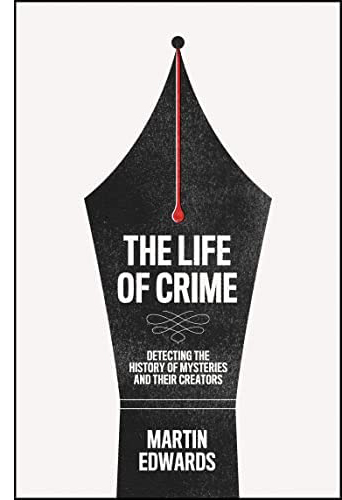 Now, fifty years after Bloody Murder, comes our most comprehensive and nuanced account of the entire genre’s development. Now, fifty years after Bloody Murder, comes our most comprehensive and nuanced account of the entire genre’s development.
Martin Edwards’ Wikipedia entry makes your head swim: the man is a true polymath. Trained in the law and still a consulting solicitor, he’s a prolific, highly lauded mystery novelist as well. He has won virtually every literary prize in the field, not least the Diamond Dagger, the British Crime Writer’s Association highest award. His most recent novel, published on 1 September, is The Blackstone Fell.
Edwards is also recognized as the premiere historian of the genre in English, thanks to his many books, including The Golden Age of Murder (2016) and The Story of Classic Crime in 100 Books (2017). As if all this didn’t keep him busy enough, he writes a lively blog, “Do You Write Under Your Own Name? And he’s incapable of composing a graceless sentence.
So it’s no surprise that The Life of Crime: Detecting the History of Mysteries and Their Creators is a monumental achievement. At 724 pages, resplendent with a burgandy string bookmark and beautiful colored end papers, it’s a triumph of modern publishing, and a stupendous bargain. (It’s currently going for $26.39 from the publisher.) The hardcover is currently ranked as #1 in Amazon’s Mystery and Detective Literary Criticism (with the audible book as #2).
The bulk and detail of The Life of Crime will incline many to treat it as a reference book. It functions superbly as that, thanks to a careful index, but it is even more. It provides a nuanced, reliable history of the genre; it offers rich insights into storytelling technique; and it teems with unforgettable stories of mystery authors. As the subtitle promises, it’s an account of both books and the people who create them.
Crime waves
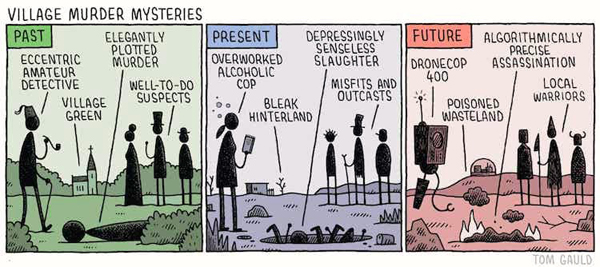
By Tom Gauld.
At the end of the 1930s, Haycraft’s Murder for Pleasure could confidently sum up the standard trajectory. The detective story developed from Poe to Gaboriau to Conan Doyle, and then to the Golden Age of Christie, Sayers, Carr, Van Dine, Queen, and many others. Haycraft acknowledges the accomplishments of the 1920s British school, their US counterparts, and the emerging hardboiled trend typified by Dashiell Hammett. (Chandler was still a secondary figure when Haycraft was writing.)
Following the most self-conscious writers of the 1930s, Haycraft recognizes the need for the mystery to move closer to prestige fiction. He suggests it do so through a greater emphasis on characterization and on social commentary: the “novel of character” and the “novel of manners.” He sees the hardboiled trend as a variant of the novel of manners and warns that in its pure form it will soon wane. It “is beginning to become just a little tedious from too much repetition of its rather limited themes.”
Time would prove him wrong. The 1940s saw new variations in the hardboiled school, most evident in the spectacular popularity of Mickey Spillane. In Bloody Murder Symons faulted Haycraft’s analysis on other grounds. He failed to discern the growing power of the “crime story” as distinct from the detective tale. Thanks largely to Hammett, violence, eroticism, abnormal psychology, and official corruption moved to the center of writers’ concerns.
For Symons the apparatus of footprints, altered wills, and bodies in the library was surpassed by the rise of suspense fiction and the police procedural. Patricia Highsmith, Symons declared, is “the most important crime novelist at present in practice.” She, along with Margaret Millar, John Bingham, and Symons himself (!) typified the potential of the modern crime story, with Ross Macdonald revising the classic detective plot through the concern for “personal identity and the investigation of the past.”
Edwards holds Symons in high regard but has a more pluralistic conception of the genre’s history. The Life of Crime reaches back to the eighteenth century (William Godwin’s Caleb Williams) and ends with surveys of Nordic noir, East Asian detection, the contributions of contemporary women and minority writers, and the fashion for historical mysteries. The 55 chapters are organized around periods, trends, and exemplary figures. They survey not only crime literature, but plays, films, and television shows.
The broad picture Edwards paints shows how changes in the genre coincide with broader social dynamics. He’s especially good on the impact of World War I on an entire generation of writers and readers. Likewise, he traces how World War II spurred the rise of psychological thrillers in fiction and film, as well as the new platform of paperback originals.
Edwards’ comparative approach shows that the clash of Golden Age and hardboiled tendencies isn’t as drastic as Symons suggested. Symons saw Hammett and Chandler as in rebellion against the “rules” of the classic whodunit. Edwards shows that the hardboiled writers respected not only many Golden Age authors but also many of their conventions. For Edwards, the mystery tradition offers writers a range of creative choices not limited to a single notion of form or style.
An unabashed fan of Christie, Sayers, and their peers, Edwards is especially good at tracing the continuing influence of the Golden Age on contemporary work around the world. Who would have predicted the obsession of contemporary Japanese novelists with impossible crimes and narrative tricks, stemming from the canonical Edogawa Ranpo’s love of classic artifice? Popular examples are Shimada Soji’s Tokyo Zodiac Murders (1981) and Higashino Keigo’s The Devotion of Suspect X (2006). Edwards introduced me to a remarkable “book” by Awasaka Tsumao, The Living and the Dead, which, thanks to the Golden Age trick of sealed pages, contains a short story that disappears as you read the novel. The author, not coincidentally, is a magician.
One of the most striking assets of the book is the endnotes at the end of each chapter. Far from academic citations, these notes are often wide-roaming discussions of topics mentioned in the text. So, for instance, R. Austin Freeman’s worry that fingerprints could be fabricated gets this elaboration in an endnote:
Fingerprinting was used by Scotland Yard from 1901, but Sherlock Holmes examined for a thumbprint eleven years earlier, in The Sign of Four. In the US, fingerprint identification was central to the plot of Pudd’nhead Wilson, by Mark Twain (Samuel Langhorne Clemens). But Freeman feared that reliance on uncorroborated fingerprint evidence could lead to miscarriages of justice. Hammett’s story “Slippery Fingers” reflects a similar concern, and some experts share it to this day (113, n8).
The dozens of reader-friendly endnotes offer a wealth of supplementary information, including recommendations for further reading. Any chapter’s supplements could provide scholars a host of leads for further research. These notes typify the generosity of the book, whose vastness conveys not pedantry but an eagerness to share information and excite the reader’s curiosity.
Edwards’ pluralism amounts to more than intellectual generosity. His book’s global sweep illustrates the astonishing fecundity of the genre in varying cultural contexts; it also shows how malleable its conventions are. I think he shows how fertile a tradition of popular storytelling can be–especially when it has the power to cross boundaries of time, place, and language. No reader of The Life of Crime can believe that this genre has run out of steam.
The toolbox
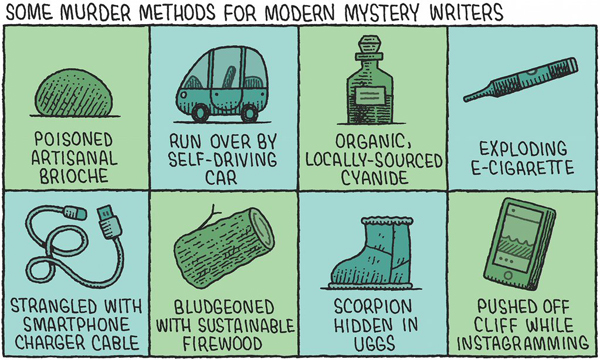
Tom Gauld, The Guardian (9 January 2016).
Most authors surveying the history of mystery discuss the narrative techniques employed by the various schools. Unlike most genres, mystery fiction’s identity depends on duplicitous manipulations of time, viewpoint, and narration. To conceal the crime and its perpetrator, the author must carefully select who knows what and when. The goal is to baffle both the investigators and the reader, with not only clues on the scene but also hints in the manner of telling. Needless to say, those clues and hints may be misleading.
Both Haycraft and Symons dutifully invoked the conventions of Golden Age bafflement. Haycraft treated them as the source of the genre’s distinctive pleasures, while Symons sometimes deplored their reliance on implausibility and coincidence. (He wasn’t, however, as demanding as Chandler, who famously remarked that “Fiction in any form has always intended to be realistic.”) As a writer sympathetic to Golden Age artifice, Edwards is eager to explore the whole range of devices available for mystery plotting. At this level, The Life of Crime is an encyclopedia of creative options available to the genre. Not surprisingly, Edwards’ wide compass shows that many “modern” techniques have distant historical precedents.
Aficionados recognize several ploys: false identity, faked death, slippery alibis, dying messages, equivocal clues, the absent clue (the dog that doesn’t bark in the night-time), the double bluff (X seems to have done it; wait, X is too obvious a suspect; nope, X actually did do it). Edwards goes beyond these to track how storytellers have used multiple narrators to cloud the situation and sharpen characterization. He shows the persisting power of the “inverted story,” the structure that shows the criminal committing the crime and then follows the detective’s exposure of guilt (the Columbo strategy). He devises a new term to accompany the “whodunnit” and the “howdunnit”: the whowasdunin, the plot that withholds the identity of the victim until the climax. This is a wider trend than I had realized. The same goes for the inclusion of letters and diaries in the text, which feels modern to us but actually goes back centuries.
And of course he doesn’t neglect reverse chronology, highlighted in one of those endnotes that can keep you busy for weeks:
This method of storytelling can dazzle, but only if the writers’ craftsmanship matches their courage. The possibilities are shown by Iain Pears’ novel Stone’s Fall, Jeffery Deaver’s The October List and Ragnar Jönasson’s Hulda Trilogy as well as by Simon Brett’s play Silhouette, Christopher Nolan’s film Memento, Harry and Jack Williams’ TV series Rellik, and Steve Pemberton and Reece Shearsmith’s “Once Removed,” a witty and brilliantly economical episode of Inside No. 9 (612n19).
In all, Edwards’ sensitivity to innovations allows his book to be a stimulating source of craft practices to anyone who wants to write a mystery.
Mystery and misery
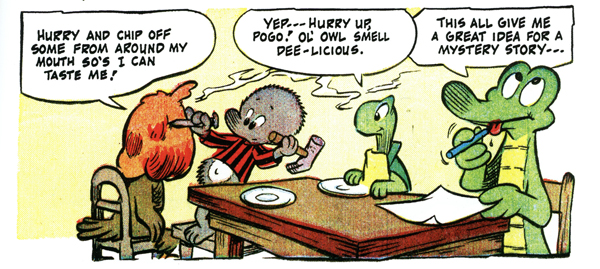
Walt Kelly, “The Big Comical Book Business” (Pogo Possum no. 5, 1951).
Sara Paretsky took up crime writing after contemplating poisoning her husband. Composer George Antheil, outraged by the attacks on his Ballet mécanique, wrote a novel in which barely disguised music critics were extravagantly murdered. Mary Roberts Rinehart refused to make one of her servants her butler, and he retaliated by trying to shoot and stab her. Patricia Highsmith smuggled her pet snails into England by hiding them in her bra, “six to ten per breast.”
At least as intriguing as the crimes in their books are the personal histories of the authors. Edward starts most chapters of The Life of Crime with an arresting account of one writer’s life. It’s often a catalogue of miseries. Alcohol damaged Poe, Hammett, Chandler, Highsmith, Craig Rice, Cornell Woolrich, and innumerable others. Drugs figured in the careers of Wilkie Collins (laudanum) and S. S. Van Dine (morphine). Suicide attempts and mental illness were distressingly common as well.
These usual artworld excesses are enhanced by mystery-mongers’ distinctive dose of weirdness. After a devastating traffic accident, Patrick Hamilton, author of Rope and Gas Light, became obsessed with his brother Bruce. He refused to speak to Bruce’s wife and declared it was a pity that he, Patrick, wasn’t a woman; then he could have married Bruce. Bruce, a mystery writer himself, published a novel called A Case for Cain, in which one brother beats another to death with a golf club.
The juxtaposition of suffering and creative energy is marked. On the brink of financial ruin, morphine-addicted Willard Huntington Wright persuaded a distinguished publisher to issue three mystery novels under the pen name S. S. Van Dine. They sold in the millions and led to a long-running series. Rupert Croft-Cooke, after serving a prison term for homosexuality, fled England for Tangier and published dozens of detective novels under the name Leo Bruce. He also wrote twenty-seven volumes of autobiography called The Sensual World. Agatha Christie’s disappearance in 1926, probably due to temporary amnesia, was a response to her mother’s death and her husband’s infidelity. It didn’t hamper her immense productivity.
With his novelist’s eye, Edwards sympathizes with his subjects, but just reporting the facts still leaves you reeling. Of William Lindsay Gresham he records excessive drinking, occasional violence, and suicide attempts. When Nightmare Alley was bought for Hollywood, Gresham moved into a mansion. “He dabbled in folk-singing, and tried to ease his misery by exploring Dianetics, the precursor of Scientology, and taking an assortment of lovers. On one occasion he’d tried to hang himself on a hook, but it broke.” Years later, he killed himself with sleeping pills. “Legend has it that his pockets were stuffed with business cards bearing the inscription: No Address. No Phone. No Business. No Money. Retired.”
Edwards avoids sensationalism, but it’s good to remind us that much of the entertainment we enjoy was built on a lot of personal pain.
The Life of Crime is, then, a book in four dimensions: reference volume, historical survey, armory of literary techniques, and biographical accounts of major artists. To succeed with any one of these is remarkable; to succeed with all of them is something of a miracle. It will remain an indispensable guide to its subject.
Full, if belated disclosure: I read Martin’s book in manuscript and offered some comments, for which he kindly thanks me. He has also provided an endorsement of my forthcoming Perplexing Plots: Popular Storytelling and the Poetics of Murder.
The Life of Crime is already getting splendid reviews in the press and on the Net. There’s an illuminating interview with Edwards on the American Scholar podcast.
You’ll find plenty of funny cartoons on writing, including writing mysteries, from Tom Gauld here and here.
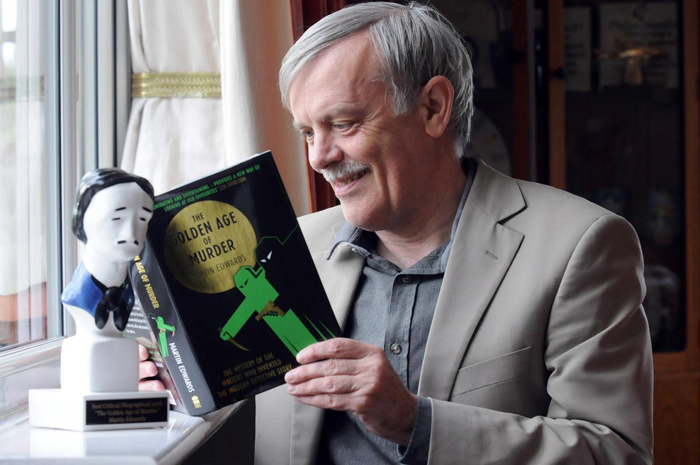
Martin Edwards. From the Warrington Guardian.
Posted in Film and other media, PERPLEXING PLOTS (the book) |  open printable version
| Comments Off on A Monument to Mystery: Martin Edwards’ THE LIFE OF CRIME open printable version
| Comments Off on A Monument to Mystery: Martin Edwards’ THE LIFE OF CRIME
|
 Carroll argues that as Western science forged ever more powerful ways of explaining the world, some thinkers took art to be “a realm unto itself, apart from the claims of utility, morality, politics, religion and so forth, a realm of art for its own sake.” Hutcheson and Kant developed ideas of beauty and our experience of it as radically distinct from other activities, and Schopenhauer extended these ideas to the realm of art works. The emergence of program music and post-Impressionist painting gave support to the notion that art works are self-sufficient. Now that art was no longer seen as a craft, as the Greeks had believed, it became a source of pleasure in its own right–an attractive idea to bourgeois patrons.
Carroll argues that as Western science forged ever more powerful ways of explaining the world, some thinkers took art to be “a realm unto itself, apart from the claims of utility, morality, politics, religion and so forth, a realm of art for its own sake.” Hutcheson and Kant developed ideas of beauty and our experience of it as radically distinct from other activities, and Schopenhauer extended these ideas to the realm of art works. The emergence of program music and post-Impressionist painting gave support to the notion that art works are self-sufficient. Now that art was no longer seen as a craft, as the Greeks had believed, it became a source of pleasure in its own right–an attractive idea to bourgeois patrons. I’ve had to be too quick in reviewing Carroll’s account, but I think it’s clear that when the Russian Formalists pronounced on art in general they sometimes moved toward autonomy assumptions. Shklovsky once remarked that art didn’t care about the color of the flag flown on the fortress. “By objects of art, in the narrow sense, we mean things created through special devices designed to make them as obviously artistic as possible.” Here we have both the idea of all-powerful form and the aesthetic experience that it fosters.
I’ve had to be too quick in reviewing Carroll’s account, but I think it’s clear that when the Russian Formalists pronounced on art in general they sometimes moved toward autonomy assumptions. Shklovsky once remarked that art didn’t care about the color of the flag flown on the fortress. “By objects of art, in the narrow sense, we mean things created through special devices designed to make them as obviously artistic as possible.” Here we have both the idea of all-powerful form and the aesthetic experience that it fosters. Tynianov is hard to read, but I think he’s probably best considered more of a functionalist than a formalist. True, he sometimes seems to reduce “content” to formal factors. Anticipating Roland Barthes in S/z, he calls a novel’s protagonist a “semantic unit. . . . a set of heterogeneous dynamic elements united under a single external sign,” such as a proper name. So much for characters as persons!
Tynianov is hard to read, but I think he’s probably best considered more of a functionalist than a formalist. True, he sometimes seems to reduce “content” to formal factors. Anticipating Roland Barthes in S/z, he calls a novel’s protagonist a “semantic unit. . . . a set of heterogeneous dynamic elements united under a single external sign,” such as a proper name. So much for characters as persons!

























































































